This document provides an introduction to time series analysis using R. It discusses key concepts like stationarity, unit roots, and integrated processes. It demonstrates how to check for stationarity in the SPY ETF price series and returns. Non-stationary price data can be made stationary by taking the first difference (returns). Unit root tests like the Augmented Dickey-Fuller test are used to formally test for a unit root. The document also shows how to access real-time market data using the IBrokers package in R.
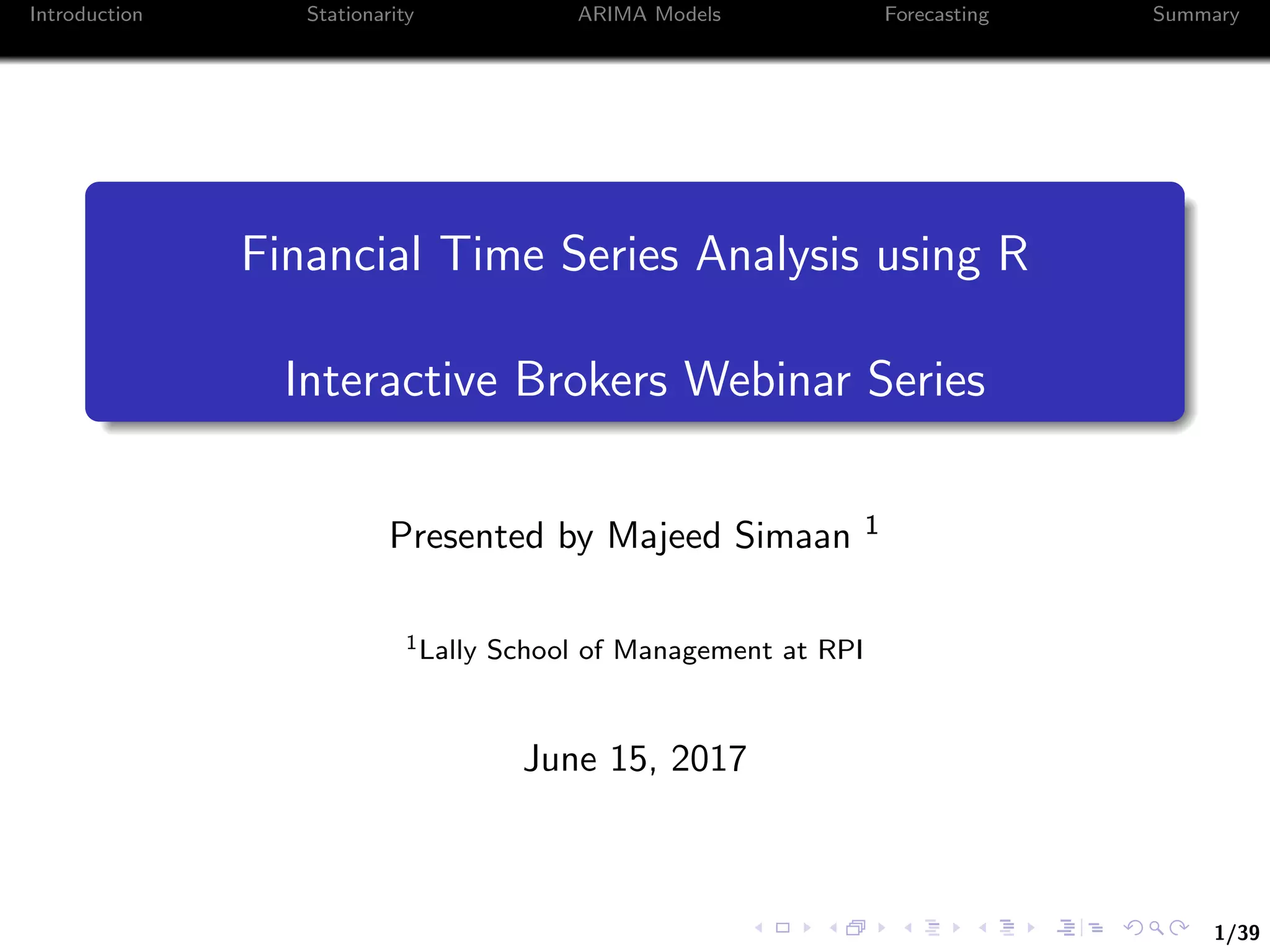
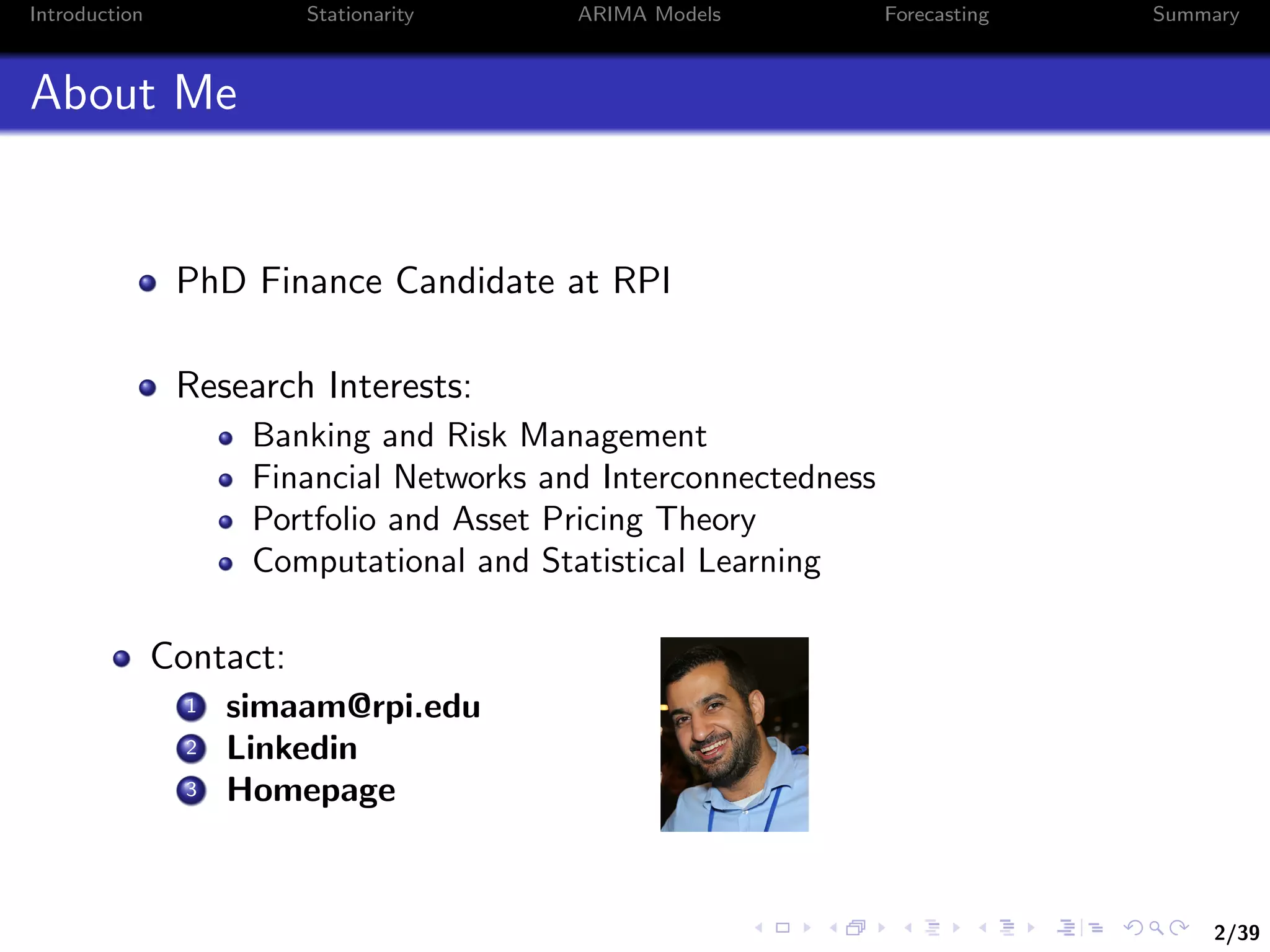
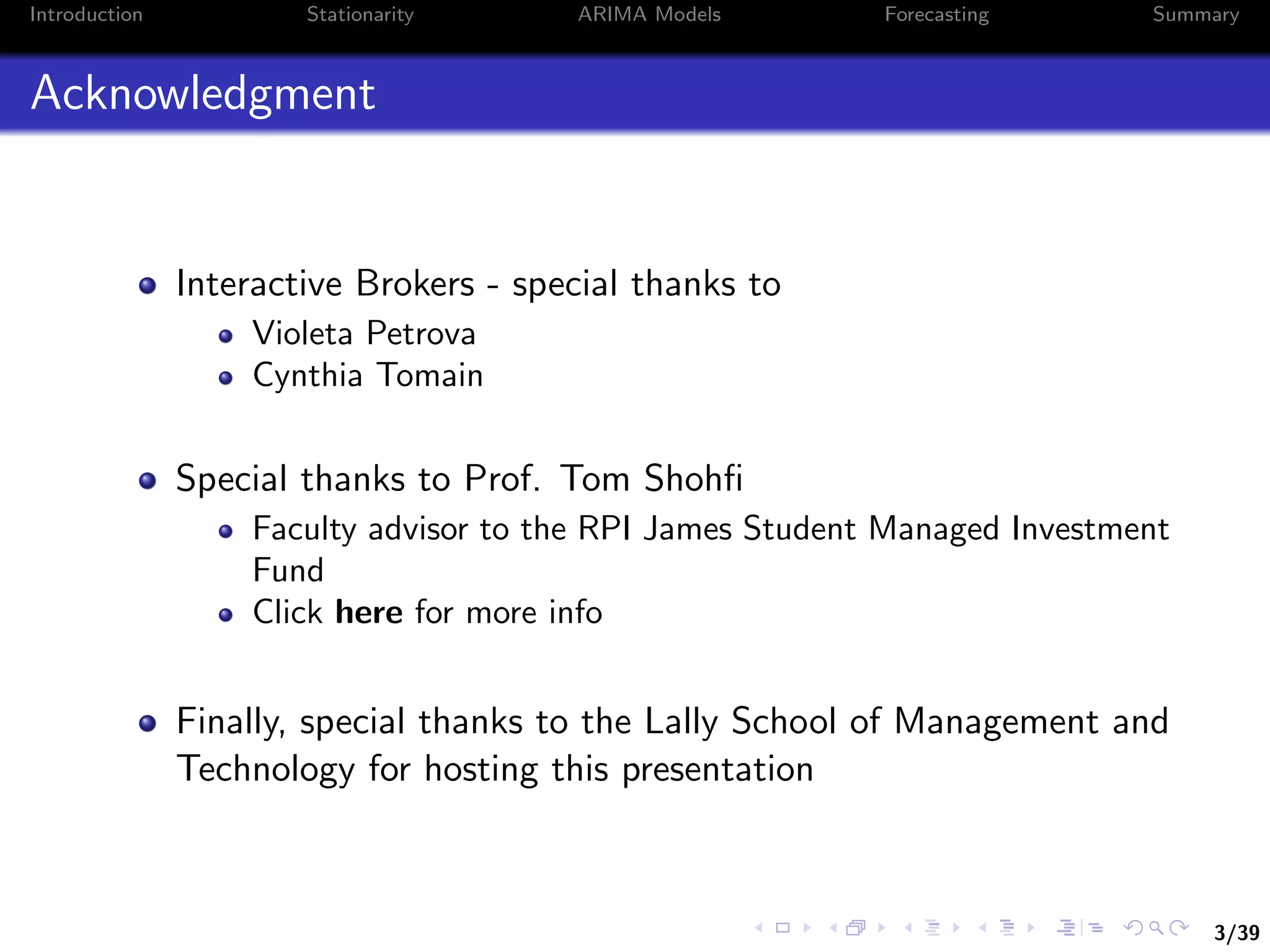
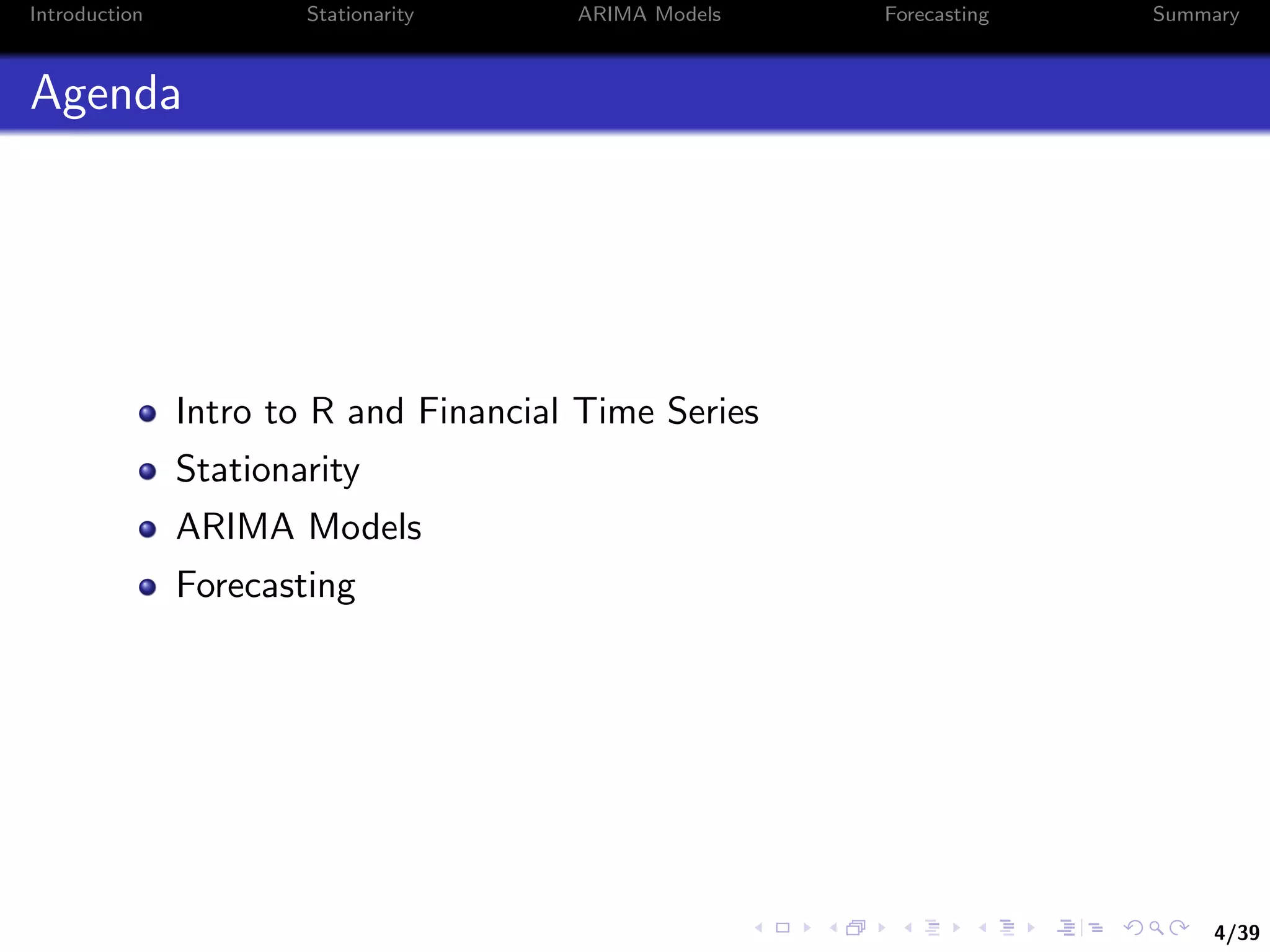
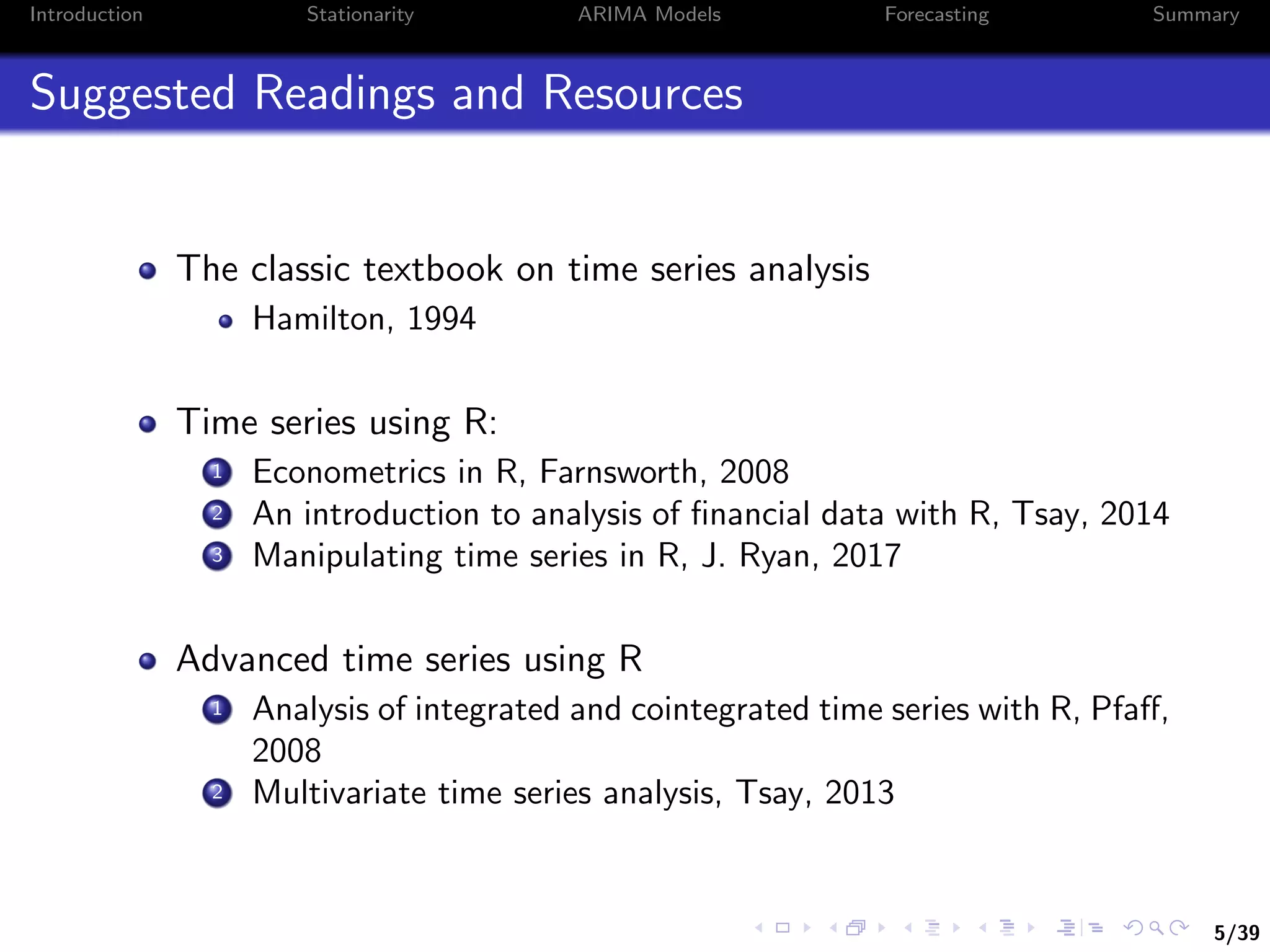

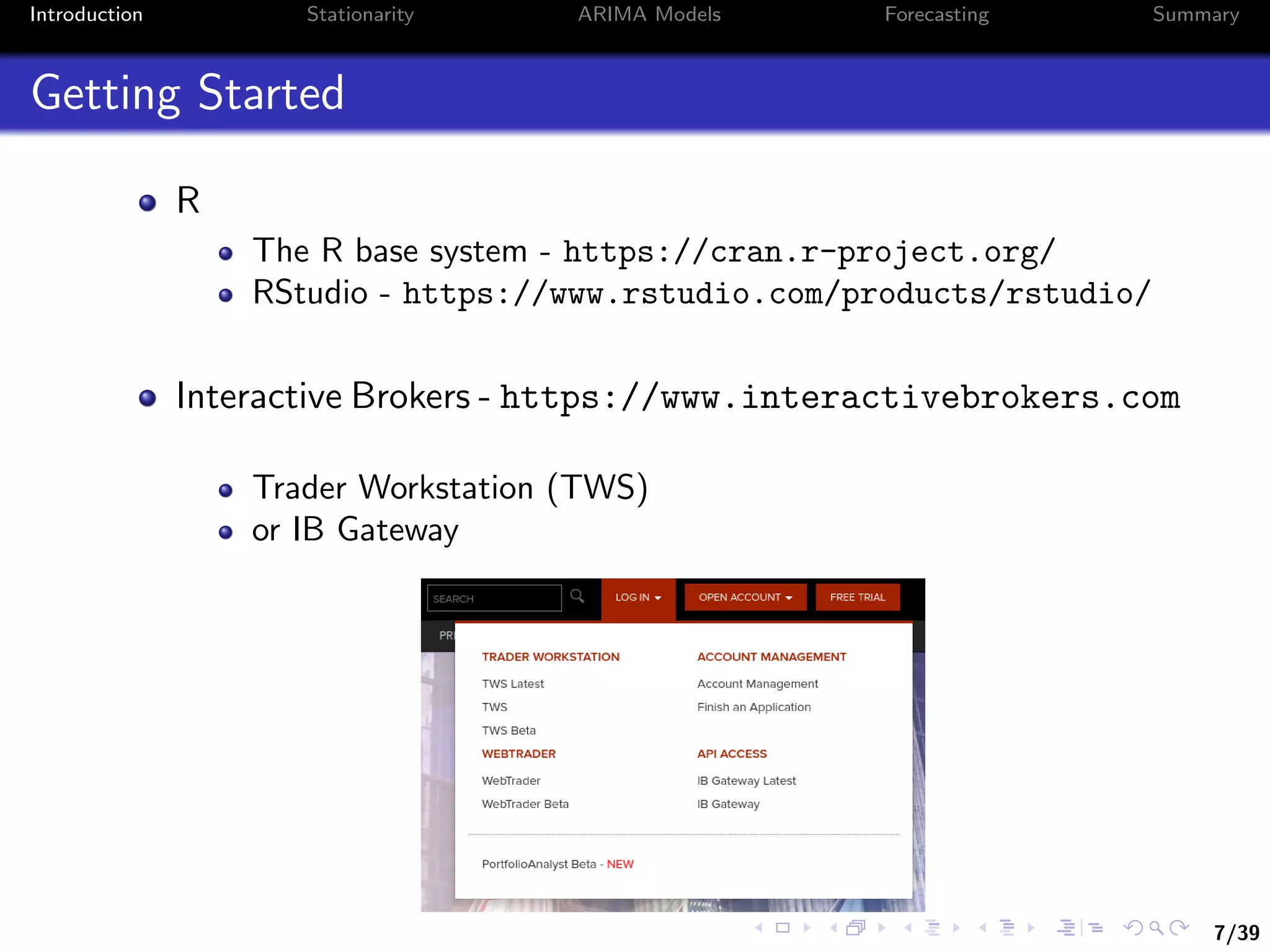
![8/39
Introduction Stationarity ARIMA Models Forecasting Summary
Time Series in R
The xts package, (J. A. Ryan & Ulrich, 2014), provides efficient
ways to manipulate time series1
> library(xts)
> library(lubridate)
> n <- 100
> set.seed(13)
> x <- rnorm(n)
> names(x) <- as.character(date(today()) - 0:(n-1))
> x <- as.xts(x)
> x[today(),]
[,1]
2017-06-08 0.5543269
1
lubridate package, (Grolemund & Wickham, 2011), makes date format handling much easier](https://image.slidesharecdn.com/2017-wb-2720financialtimeseriesanalysisusingr-170712071932/75/Financial-Time-Series-Analysis-Using-R-8-2048.jpg)
![8/39
Introduction Stationarity ARIMA Models Forecasting Summary
Time Series in R
The xts package, (J. A. Ryan & Ulrich, 2014), provides efficient
ways to manipulate time series1
> library(xts)
> library(lubridate)
> n <- 100
> set.seed(13)
> x <- rnorm(n)
> names(x) <- as.character(date(today()) - 0:(n-1))
> x <- as.xts(x)
> x[today(),]
[,1]
2017-06-08 0.5543269
# it is easy to plot an xts object
> plot(x)
Feb 27
2017
Mar 20
2017
Apr 10
2017
May 01
2017
May 22
2017
Jun 06
2017
−2−1012
x
1
lubridate package, (Grolemund & Wickham, 2011), makes date format handling much easier](https://image.slidesharecdn.com/2017-wb-2720financialtimeseriesanalysisusingr-170712071932/75/Financial-Time-Series-Analysis-Using-R-9-2048.jpg)
![9/39
Introduction Stationarity ARIMA Models Forecasting Summary
Time Series in R II
We can also look at x as a data frame instead
> x <- data.frame(Date = date(x), x = x[,1])
> rownames(x) <- NULL
> summary(x)
Date x
Min. :2017-03-01 Min. :-2.02704
1st Qu.:2017-03-25 1st Qu.:-0.75623
Median :2017-04-19 Median :-0.07927
Mean :2017-04-19 Mean :-0.06183
3rd Qu.:2017-05-14 3rd Qu.: 0.55737
Max. :2017-06-08 Max. : 1.83616
> # add year and month variables
> x$Y <- year(x$Date); x$M <- month(x$Date);](https://image.slidesharecdn.com/2017-wb-2720financialtimeseriesanalysisusingr-170712071932/75/Financial-Time-Series-Analysis-Using-R-10-2048.jpg)
![9/39
Introduction Stationarity ARIMA Models Forecasting Summary
Time Series in R II
We can also look at x as a data frame instead
> x <- data.frame(Date = date(x), x = x[,1])
> rownames(x) <- NULL
> summary(x)
Date x
Min. :2017-03-01 Min. :-2.02704
1st Qu.:2017-03-25 1st Qu.:-0.75623
Median :2017-04-19 Median :-0.07927
Mean :2017-04-19 Mean :-0.06183
3rd Qu.:2017-05-14 3rd Qu.: 0.55737
Max. :2017-06-08 Max. : 1.83616
> # add year and month variables
> x$Y <- year(x$Date); x$M <- month(x$Date);
The package plyr, (Wickham, 2011), provides efficient data split
summary
> library(plyr)
> max_month_x <- ddply(x,c("Y","M"),function(z) max(z[,"x"]))
> max_month_x # max value over month
Y M V1
1 2017 3 1.745427
2 2017 4 1.614479
3 2017 5 1.836163
4 2017 6 1.775163](https://image.slidesharecdn.com/2017-wb-2720financialtimeseriesanalysisusingr-170712071932/75/Financial-Time-Series-Analysis-Using-R-11-2048.jpg)

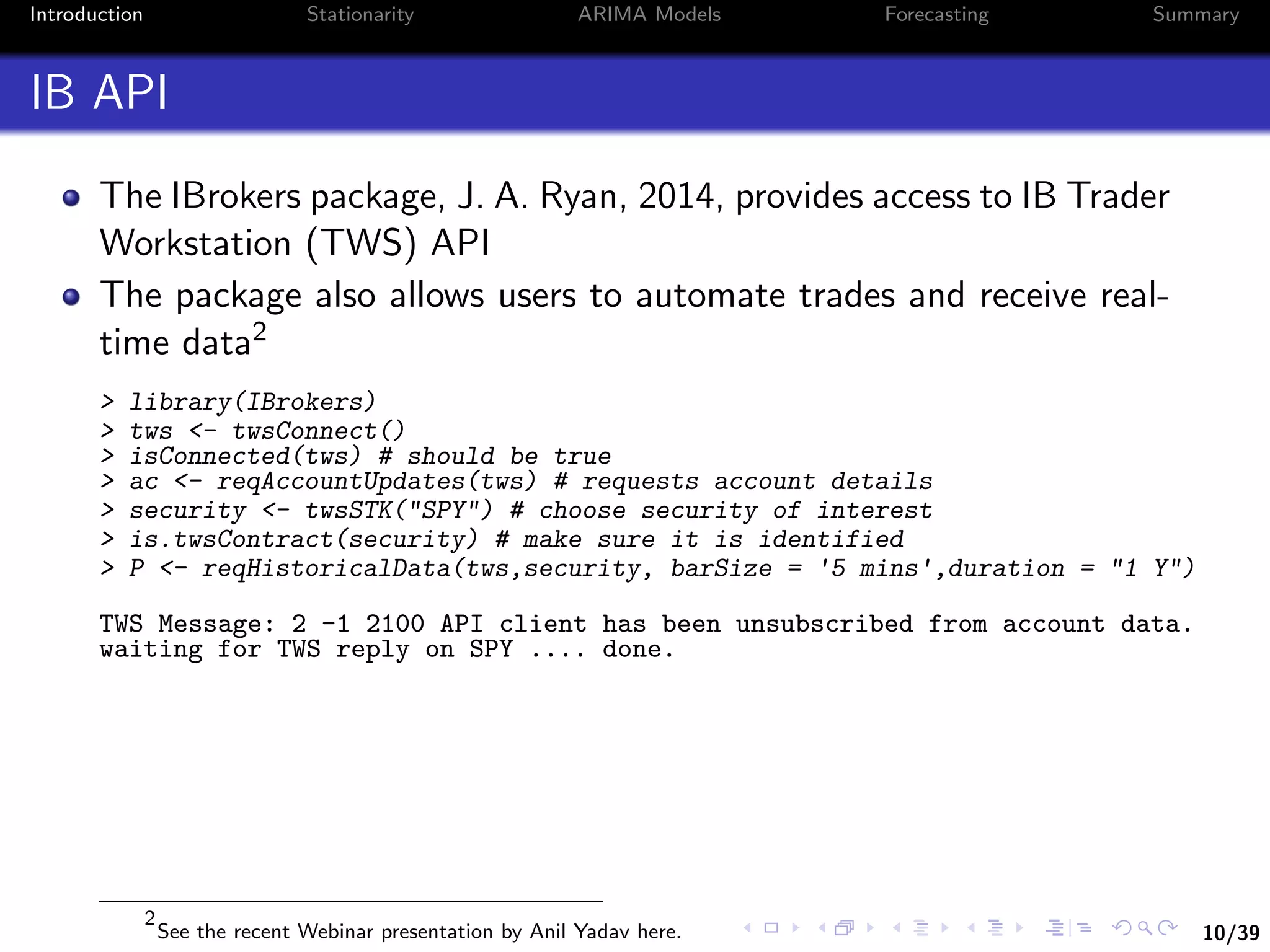
![10/39
Introduction Stationarity ARIMA Models Forecasting Summary
IB API
The IBrokers package, J. A. Ryan, 2014, provides access to IB Trader
Workstation (TWS) API
The package also allows users to automate trades and receive real-
time data2
> library(IBrokers)
> tws <- twsConnect()
> isConnected(tws) # should be true
> ac <- reqAccountUpdates(tws) # requests account details
> security <- twsSTK("SPY") # choose security of interest
> is.twsContract(security) # make sure it is identified
> P <- reqHistoricalData(tws,security, barSize = '5 mins',duration = "1 Y")
TWS Message: 2 -1 2100 API client has been unsubscribed from account data.
waiting for TWS reply on SPY .... done.
> P[c(1,nrow(P))] # look at first and last data points
SPY.Open SPY.High SPY.Low SPY.Close SPY.Volume SPY.WAP
2016-06-09 09:30:00 211.51 211.62 211.37 211.41 26766 211.501
2017-06-08 15:55:00 243.77 243.86 243.68 243.76 30984 243.772
SPY.hasGaps SPY.Count
2016-06-09 09:30:00 0 8378
2017-06-08 15:55:00 0 8952
2
See the recent Webinar presentation by Anil Yadav here.](https://image.slidesharecdn.com/2017-wb-2720financialtimeseriesanalysisusingr-170712071932/75/Financial-Time-Series-Analysis-Using-R-14-2048.jpg)
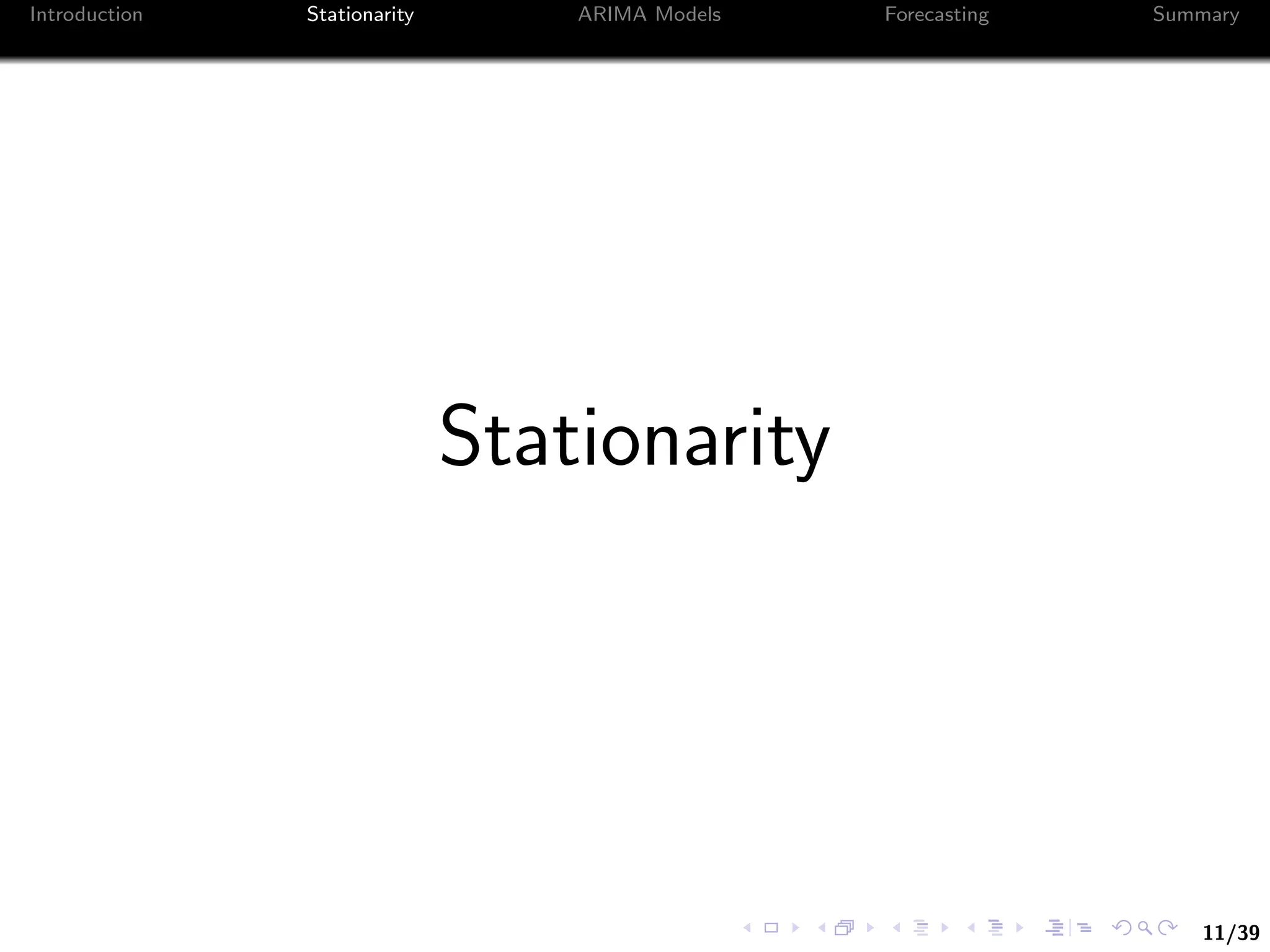
![12/39
Introduction Stationarity ARIMA Models Forecasting Summary
Basic Concepts
Let yt denote a time series observed over t = 1, .., T periods
yt is called weakly stationary, if
E[yt] = µ and V[yt] = σ2
, ∀t (1)
i.e. expectation and variance of y are time invariant
3
See for instance Tsay, 2005](https://image.slidesharecdn.com/2017-wb-2720financialtimeseriesanalysisusingr-170712071932/75/Financial-Time-Series-Analysis-Using-R-16-2048.jpg)
![12/39
Introduction Stationarity ARIMA Models Forecasting Summary
Basic Concepts
Let yt denote a time series observed over t = 1, .., T periods
yt is called weakly stationary, if
E[yt] = µ and V[yt] = σ2
, ∀t (1)
i.e. expectation and variance of y are time invariant
Also, yt is called strictly stationary, if
f (yt1 , ..., ytm ) = f (yt1+j , ..., ytm+j ) (2)
where m, j, and (t1, ..., tm) are arbitrary positive integers3
3
See for instance Tsay, 2005](https://image.slidesharecdn.com/2017-wb-2720financialtimeseriesanalysisusingr-170712071932/75/Financial-Time-Series-Analysis-Using-R-17-2048.jpg)
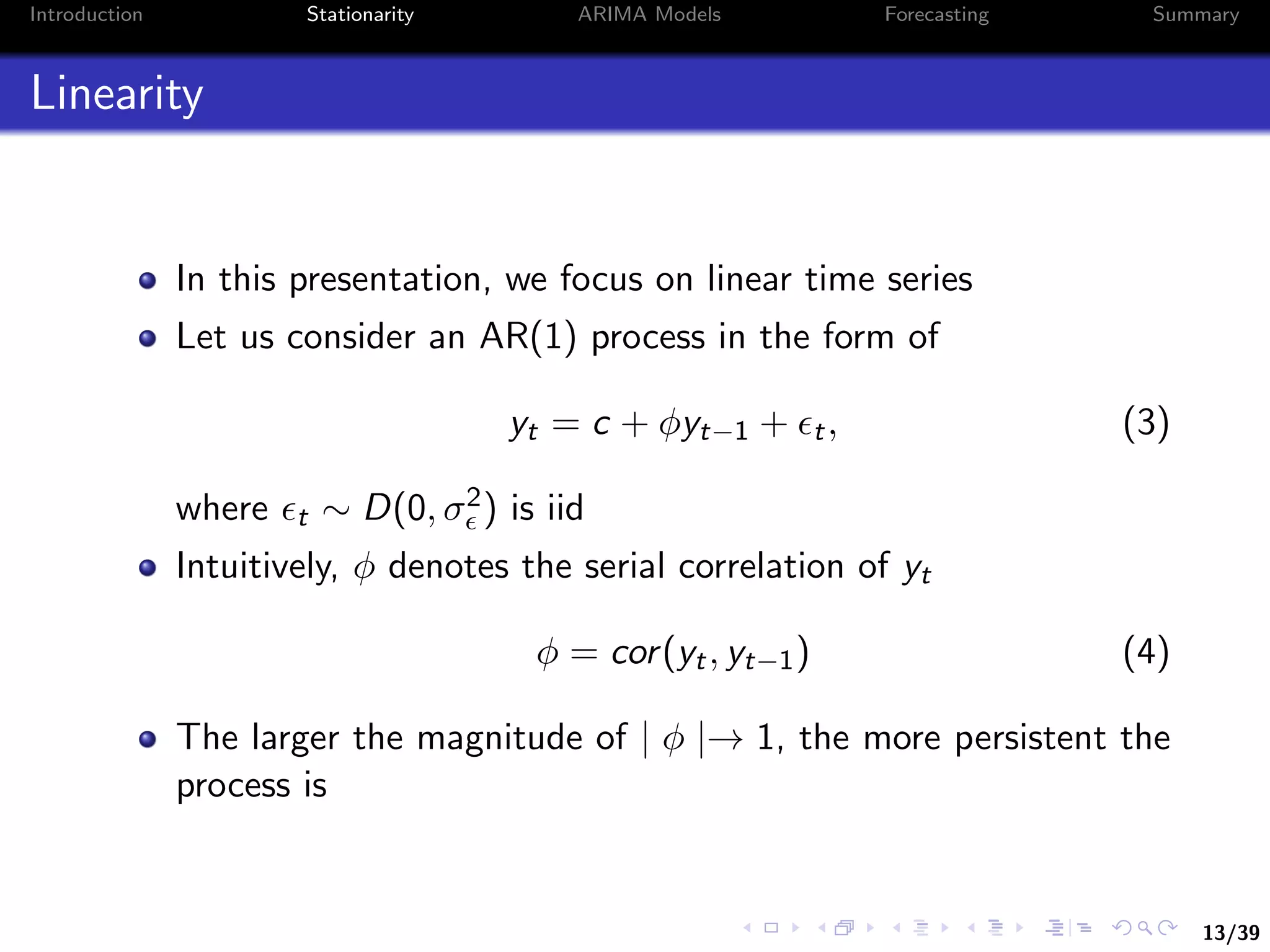
![14/39
Introduction Stationarity ARIMA Models Forecasting Summary
Unit Root
Weak stationarity holds true if E[yt] = µ < ∞ for all t, such
that
µ = c + φµ ⇒ µ =
c
1 − φ
(5)
The same applies to V[yt] = σ2 < ∞, ∀t:
σ2
= φ2
σ2
+ σ2
⇒ σ2
=
σ2
1 − φ2
(6)
A necessary condition for weak stationarity implies | φ |< 1
Unit Root
If φ = 1, the process yt is a unit root](https://image.slidesharecdn.com/2017-wb-2720financialtimeseriesanalysisusingr-170712071932/75/Financial-Time-Series-Analysis-Using-R-19-2048.jpg)
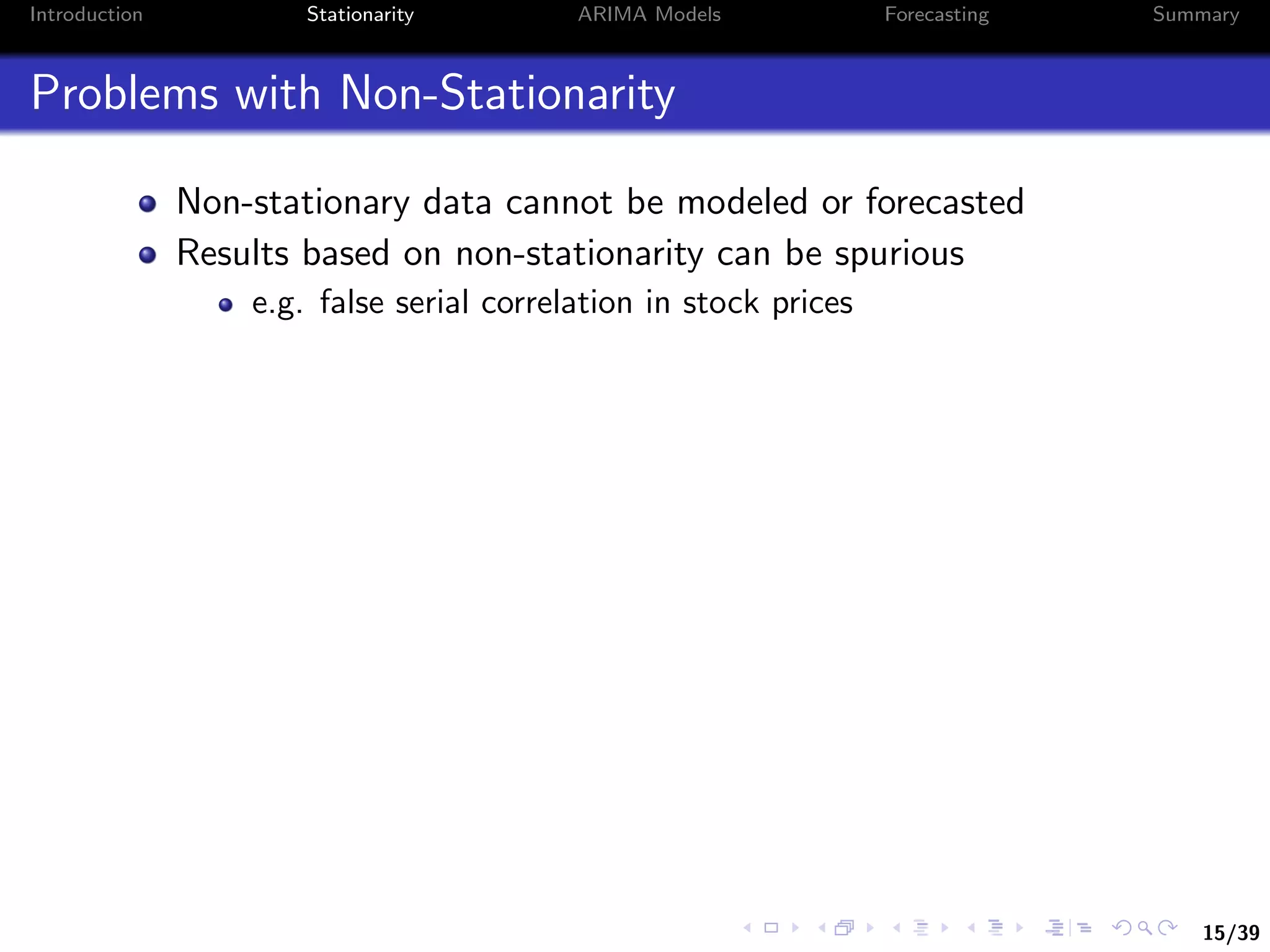
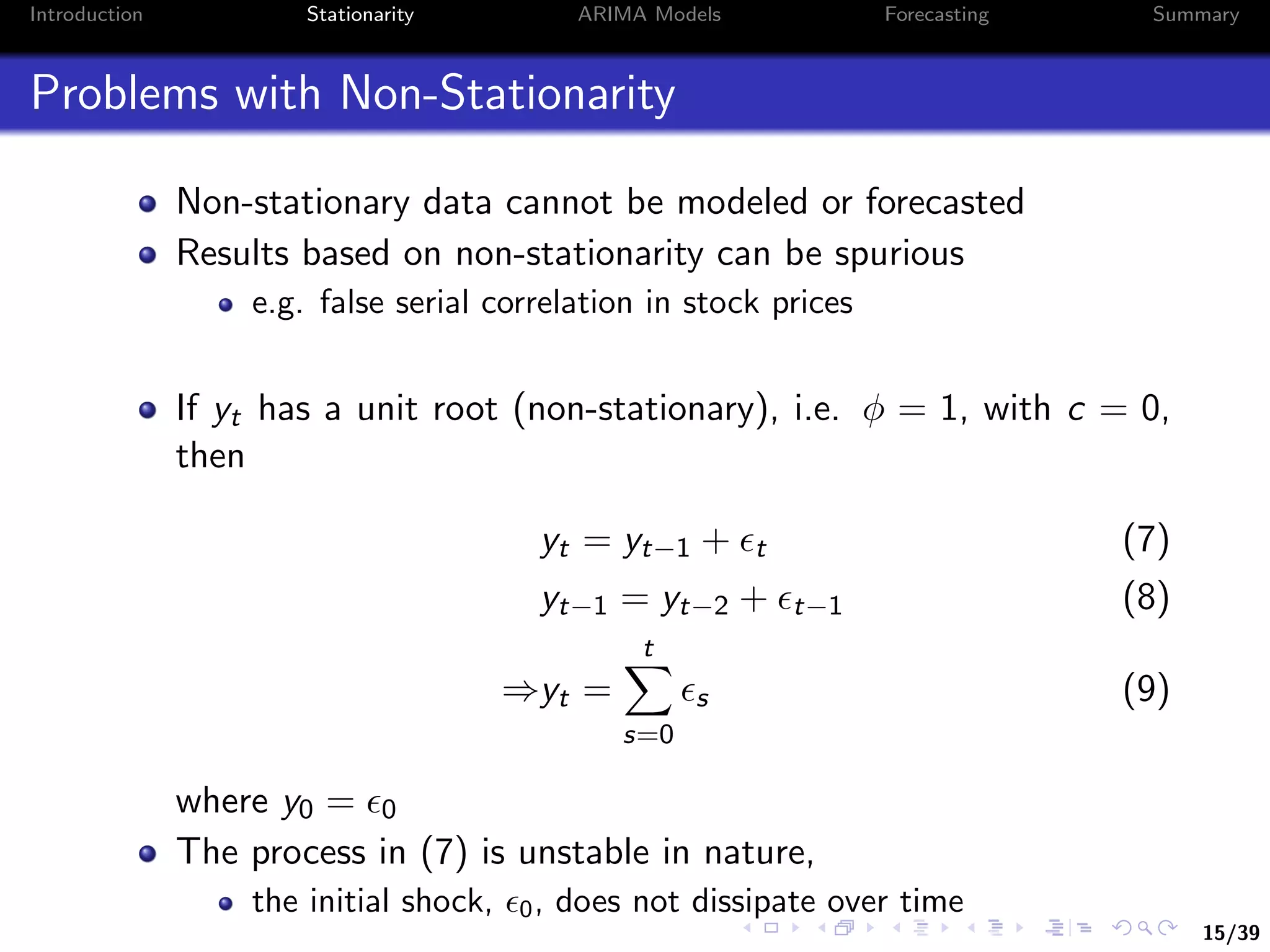
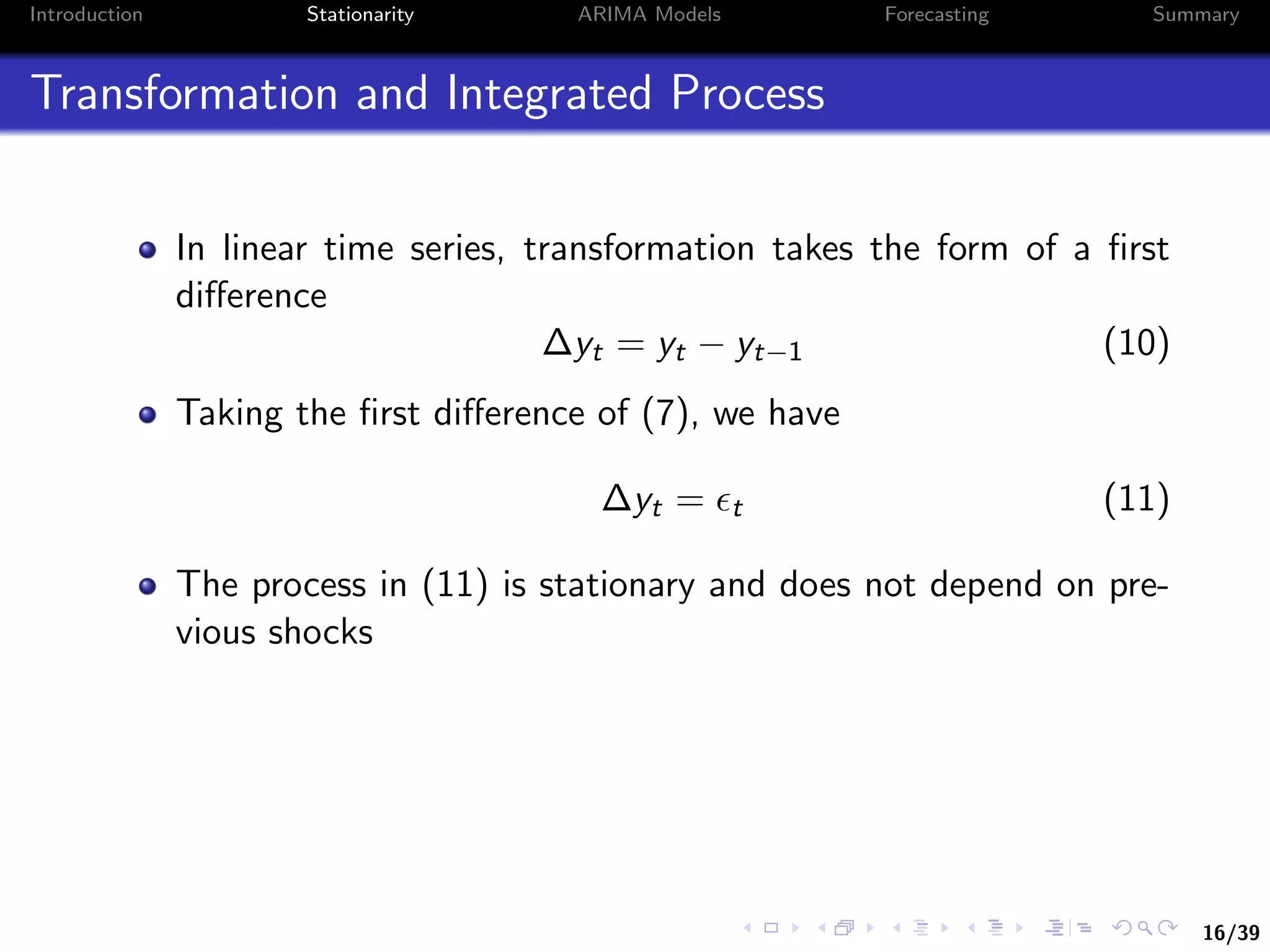

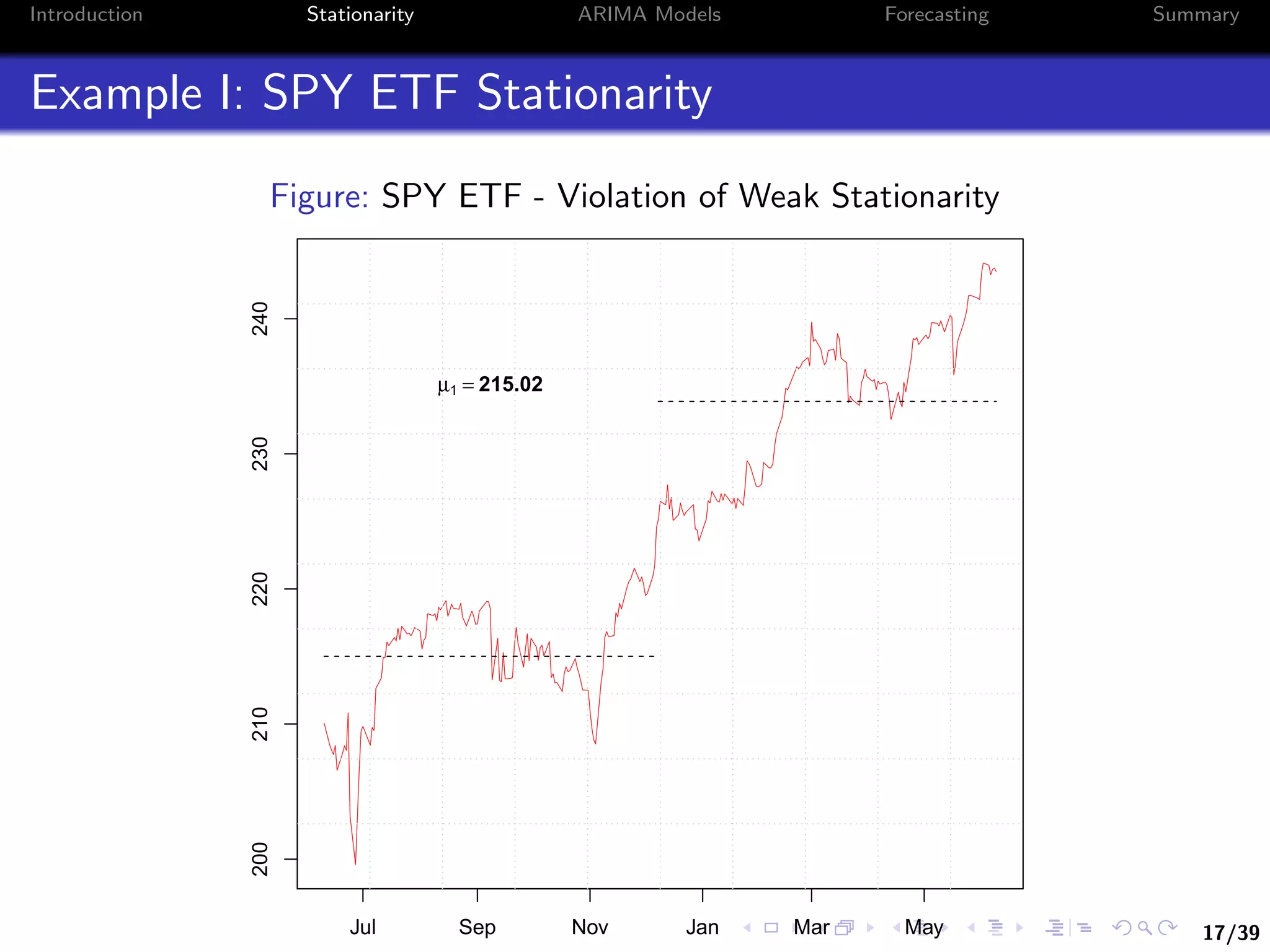
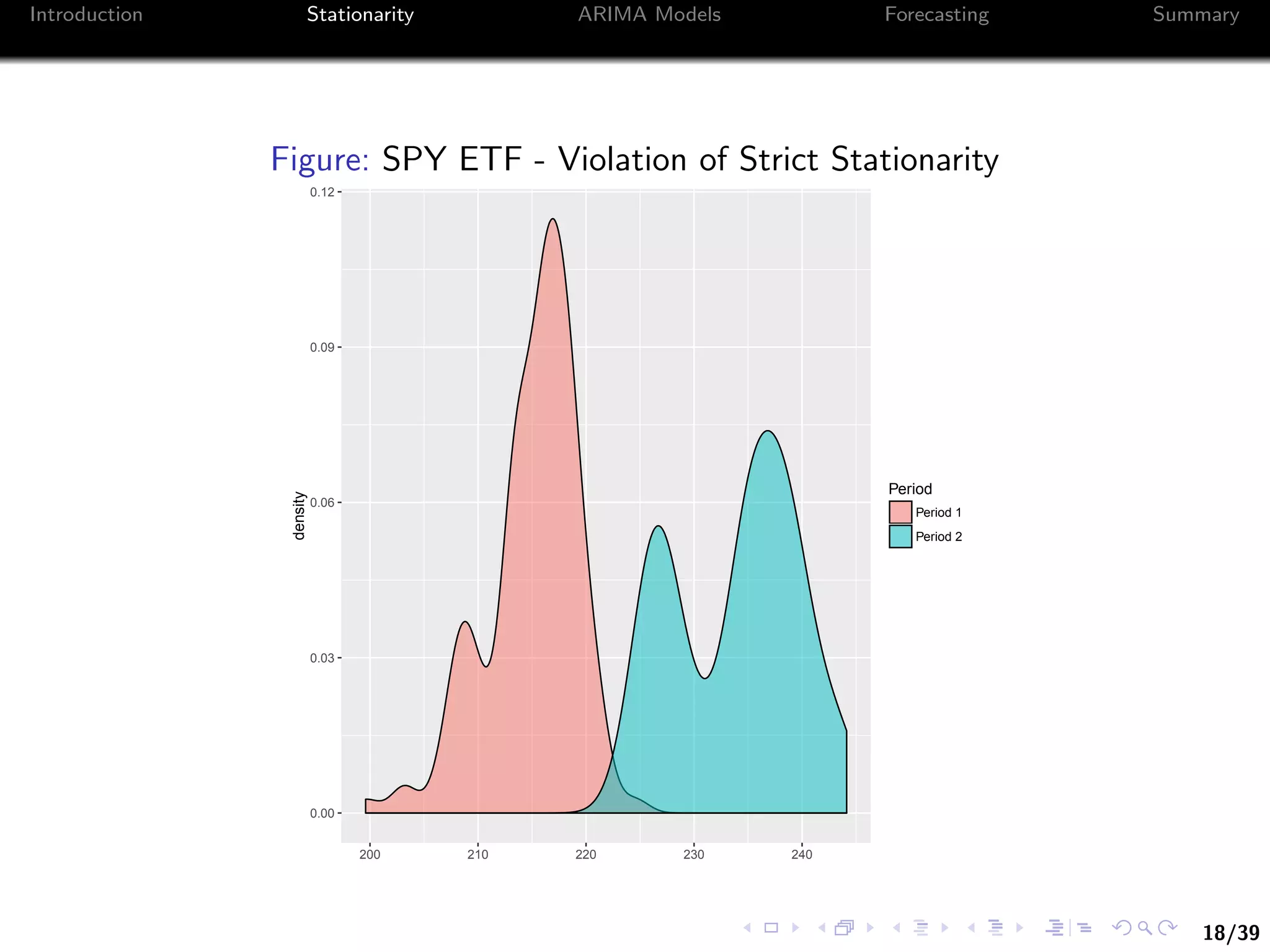
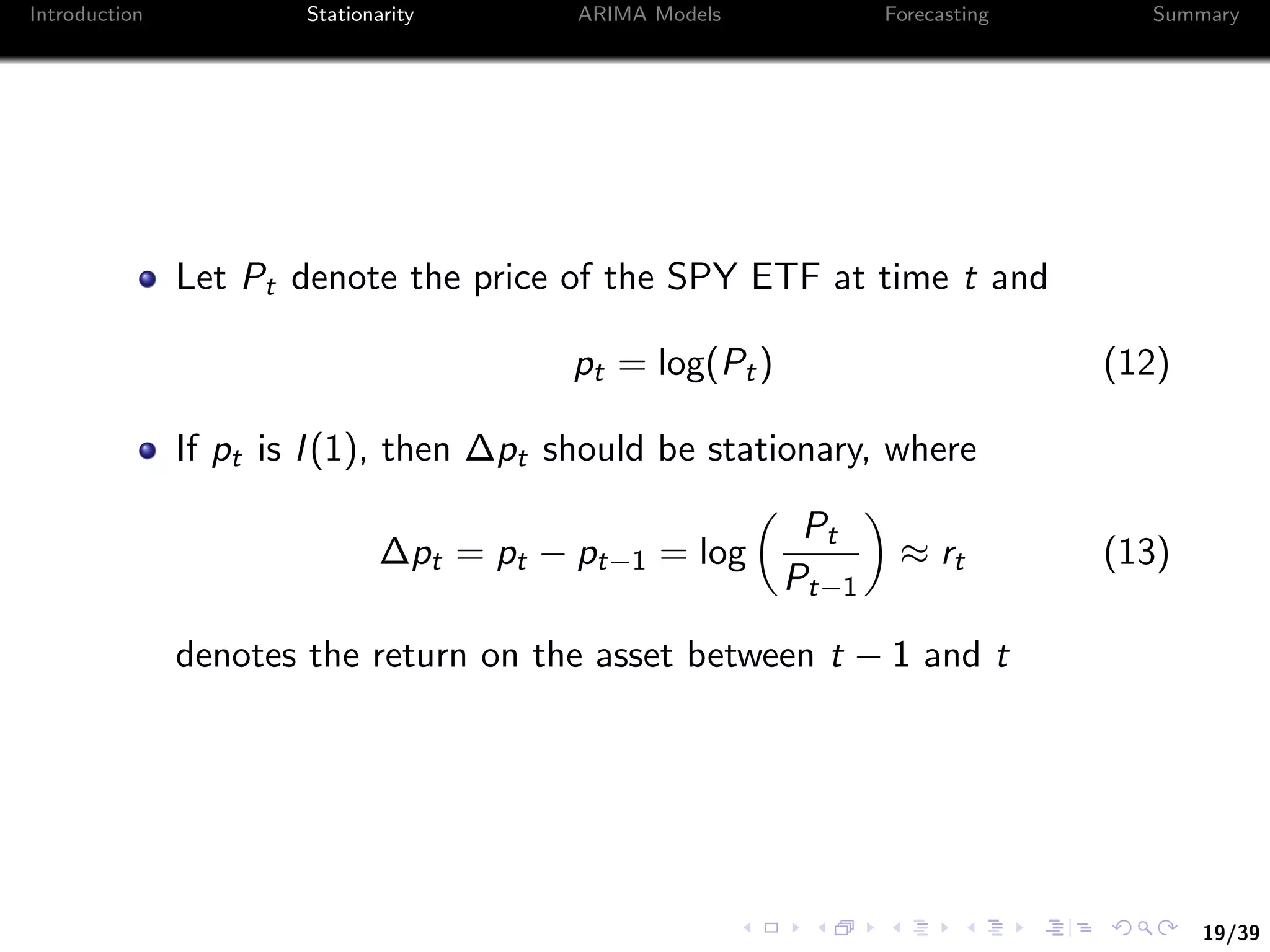
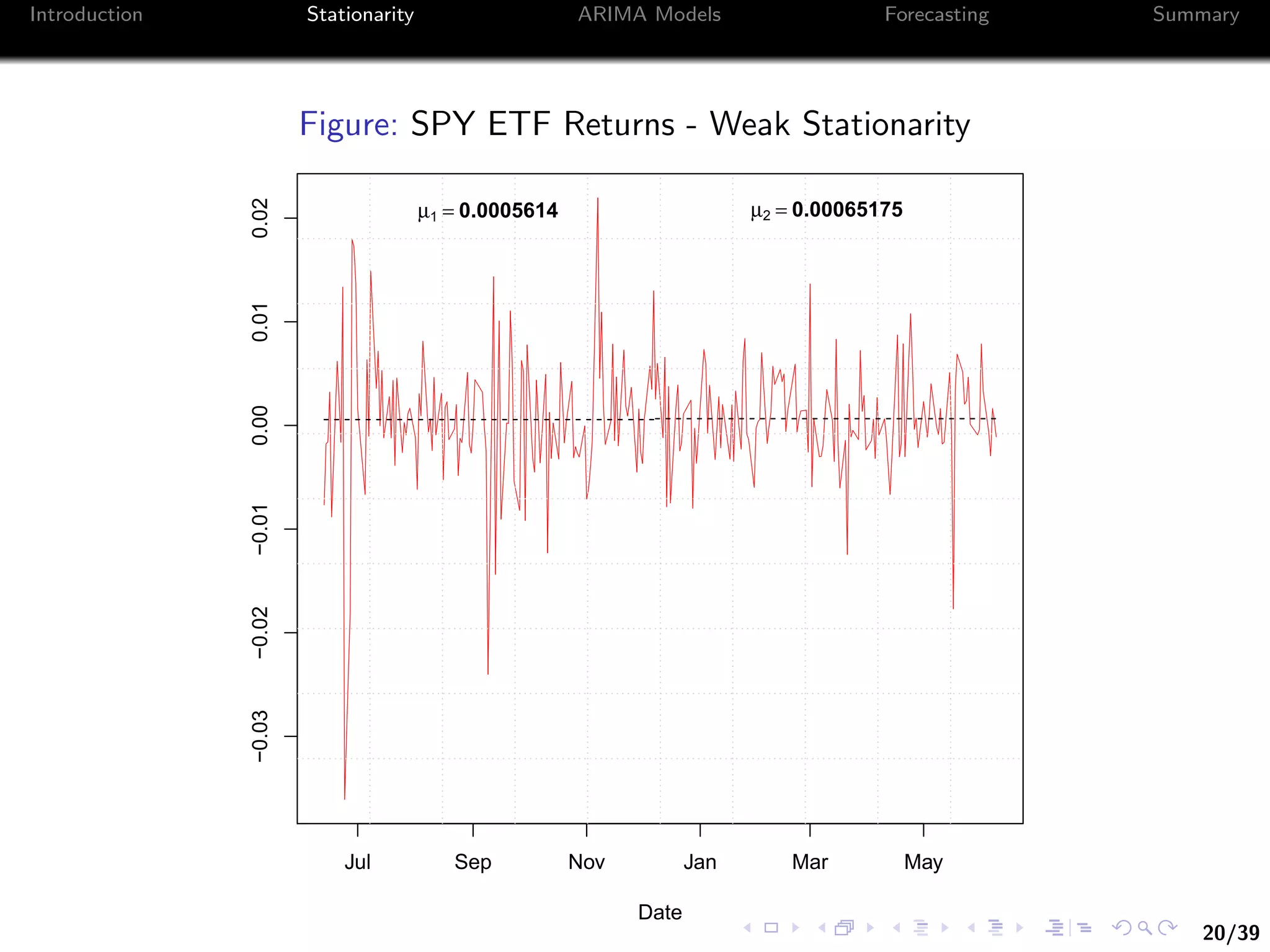
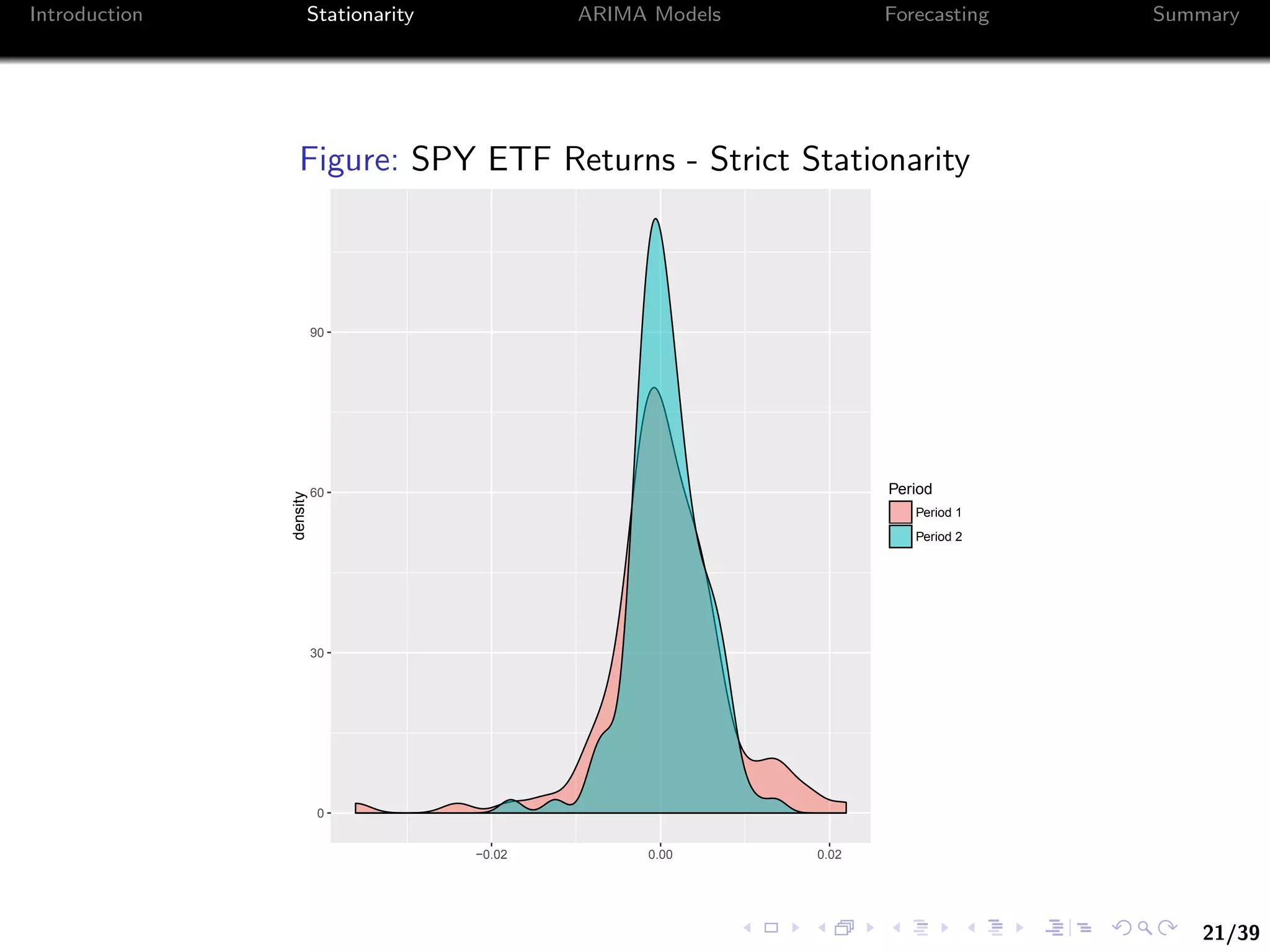
![22/39
Introduction Stationarity ARIMA Models Forecasting Summary
Let’s take a look at the serial correlation of the prices
We will focus on the closing price
> find.close <- grep("Close",names(P))
> P_daily <- apply.daily(P[,find.close],function(x) x[nrow(x),])
> dim(P_daily)
[1] 252 1
> cor(P_daily[-1],lag(P_daily)[-1])
SPY.Close
SPY.Close 0.99238](https://image.slidesharecdn.com/2017-wb-2720financialtimeseriesanalysisusingr-170712071932/75/Financial-Time-Series-Analysis-Using-R-29-2048.jpg)
![22/39
Introduction Stationarity ARIMA Models Forecasting Summary
Let’s take a look at the serial correlation of the prices
We will focus on the closing price
> find.close <- grep("Close",names(P))
> P_daily <- apply.daily(P[,find.close],function(x) x[nrow(x),])
> dim(P_daily)
[1] 252 1
> cor(P_daily[-1],lag(P_daily)[-1])
SPY.Close
SPY.Close 0.99238
On the other hand, the corresponding statistic for returns is
> R_daily <- P_daily[-1]/lag(P_daily)[-1] - 1
> cor(R_daily[-1],lag(R_daily)[-1])
SPY.Close
SPY.Close -0.06828564](https://image.slidesharecdn.com/2017-wb-2720financialtimeseriesanalysisusingr-170712071932/75/Financial-Time-Series-Analysis-Using-R-30-2048.jpg)
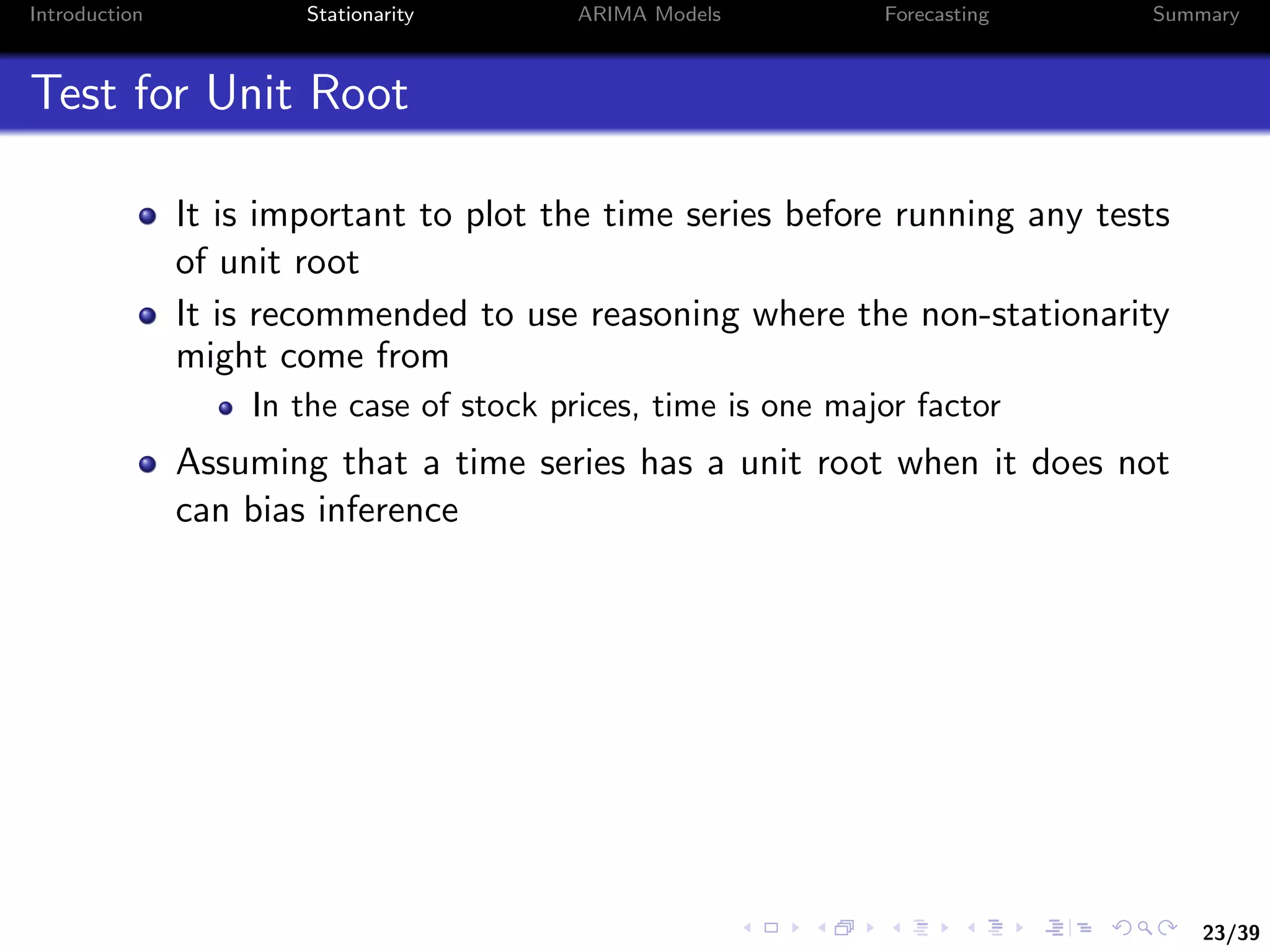
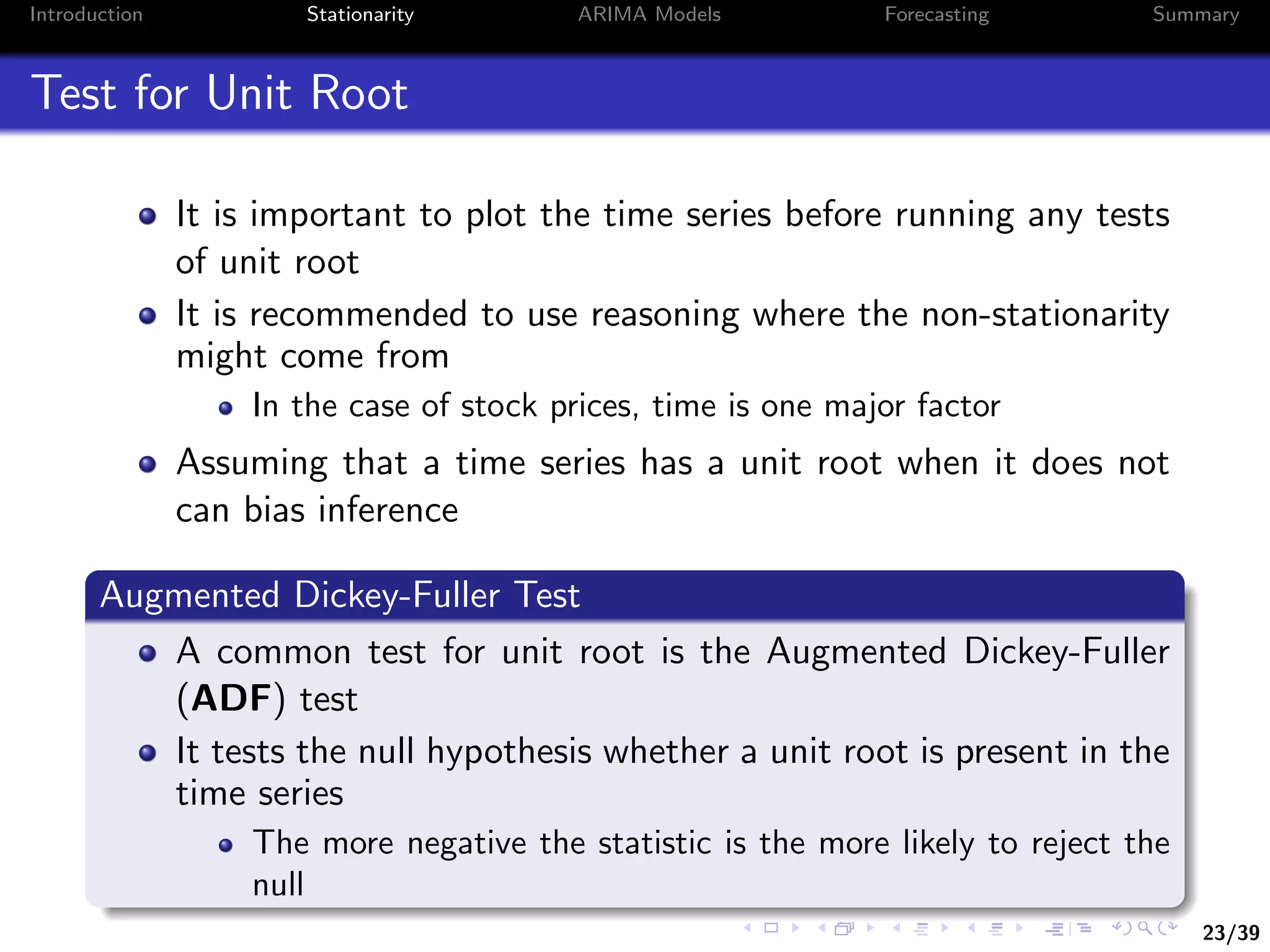

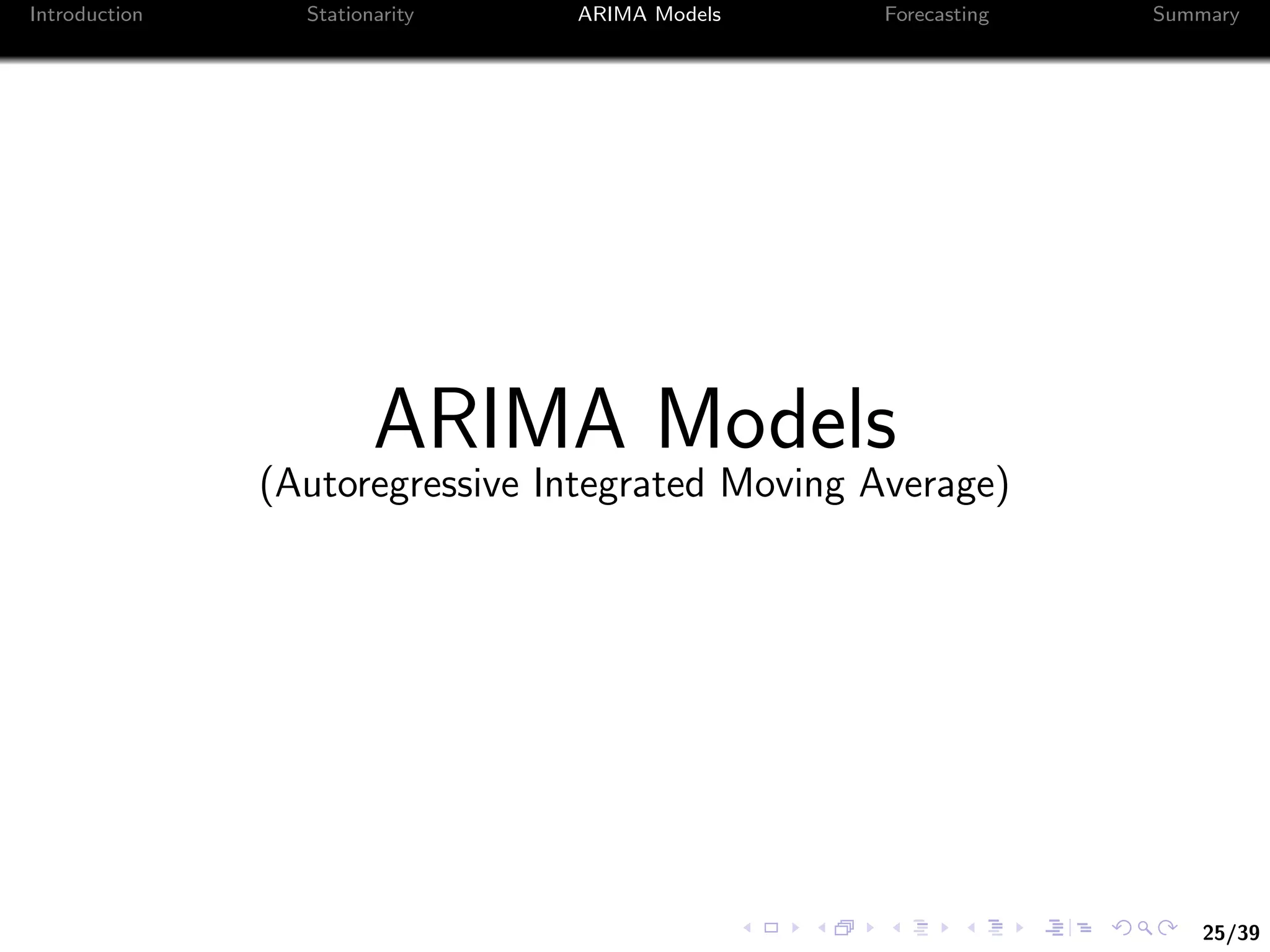
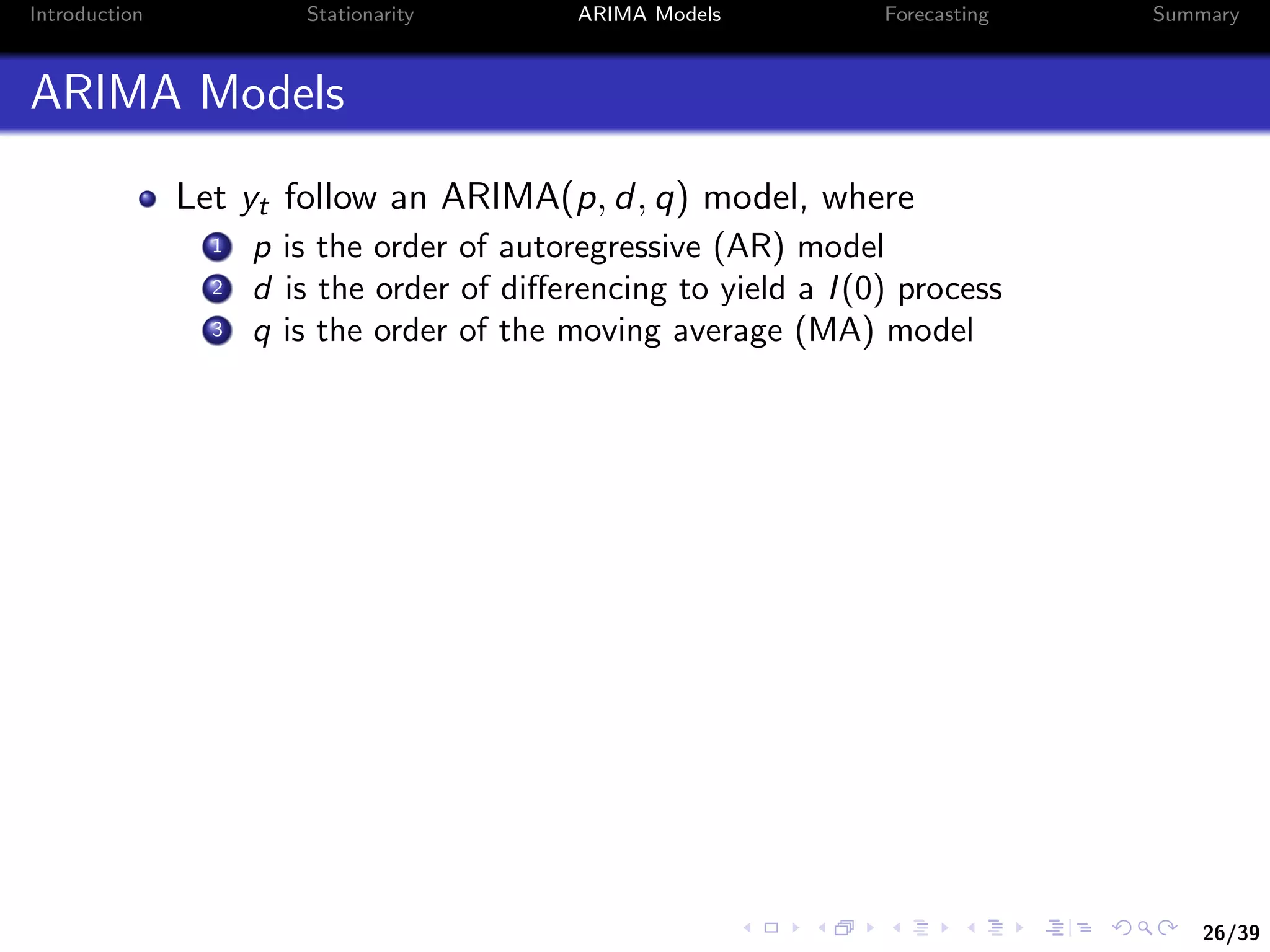
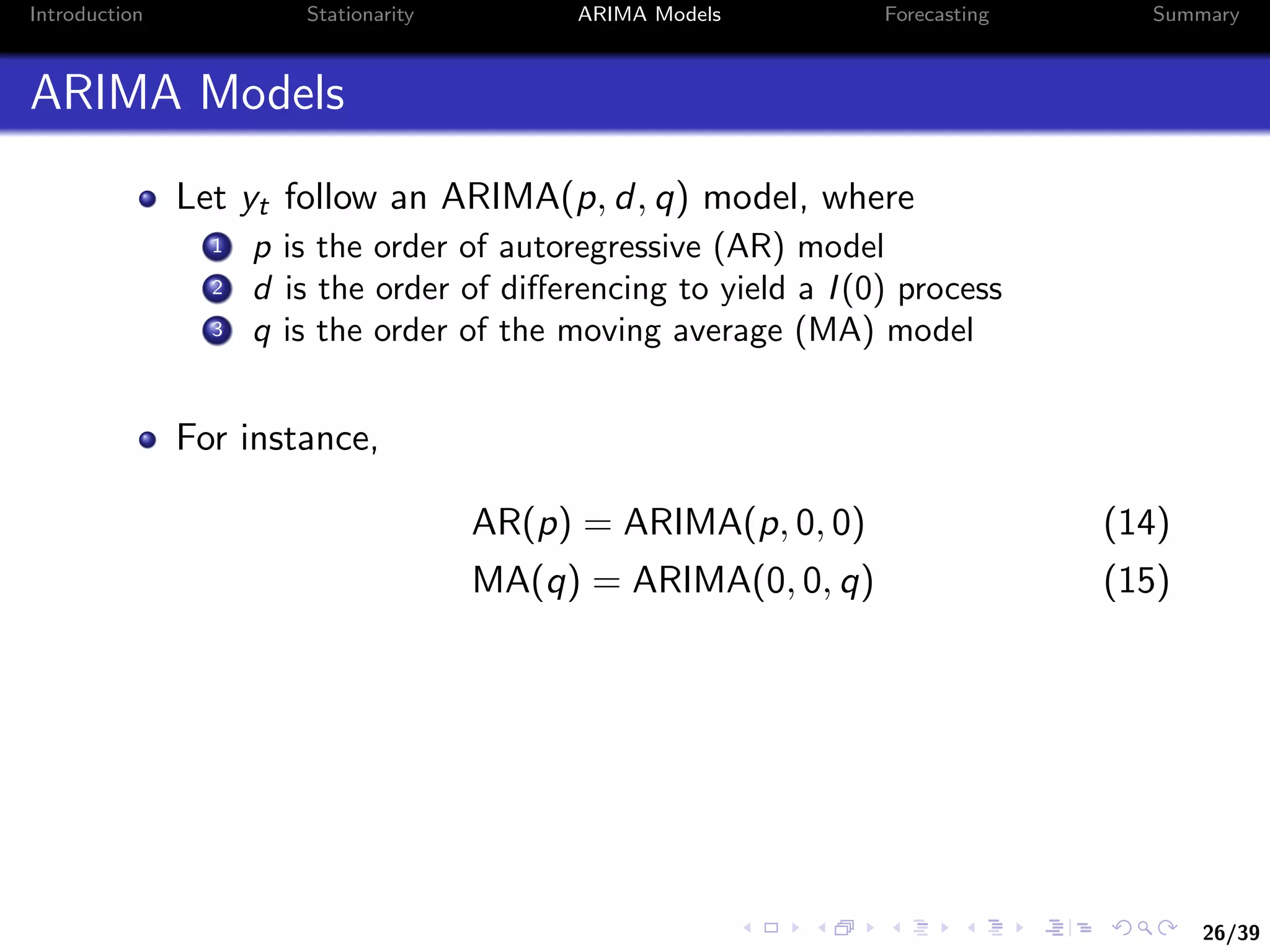
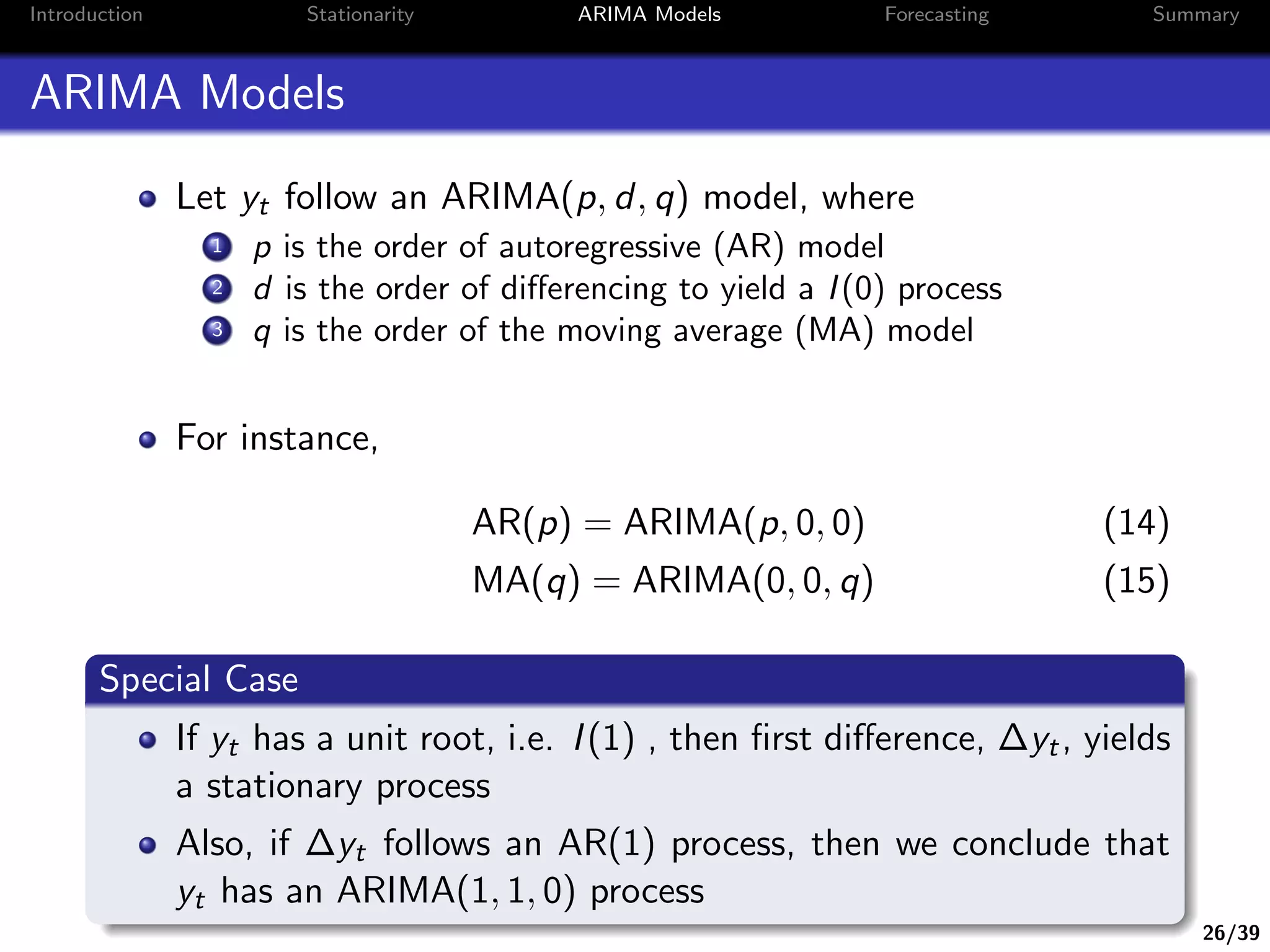

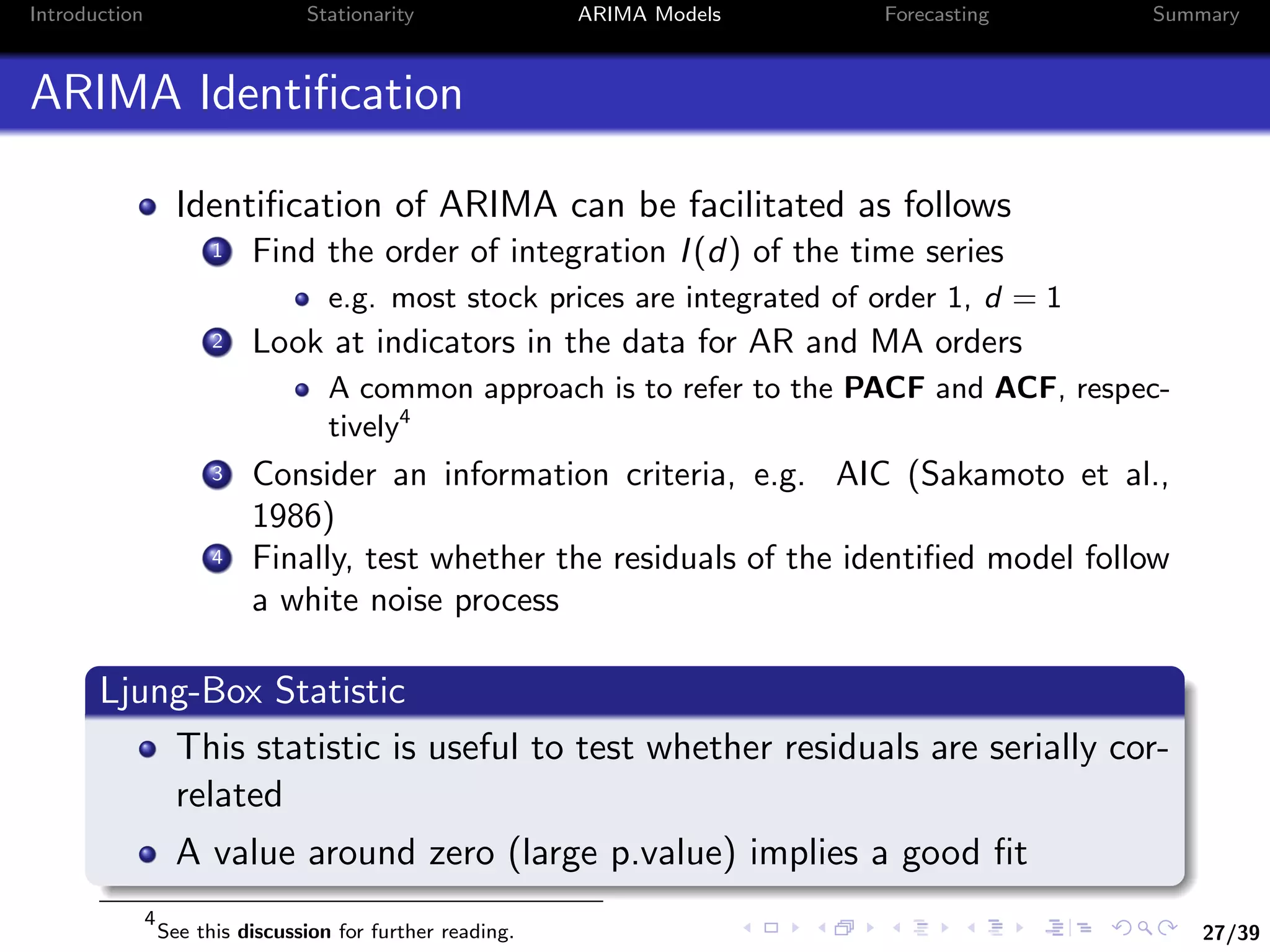
![28/39
Introduction Stationarity ARIMA Models Forecasting Summary
Example II: Identifying ARIMA Models
We consider a simulated time series from a given ARIMA model
Specifically, we consider an ARIMA(3,1,2) process
> N <- 10^3
> set.seed(13)
> y <- arima.sim(N,model = list(order = c(3,1,2), ar = c(0.8, -0.5,0.4),
+ ma = c(0.5,-0.3))) + 200
# Note that y is a ts object rather than xts
Step 1: Plot and Test for Unit Root
> plot(y);
> ADF <- adf.test(y); ADF$p.value
[1] 0.4148301
# lag on ts object should be assigned as -1
> delta_y <- na.omit(y - lag(y,-1) )
> plot(delta_y);
> ADF2 <- adf.test(delta_y); ADF2$p.value
[1] 0.01](https://image.slidesharecdn.com/2017-wb-2720financialtimeseriesanalysisusingr-170712071932/75/Financial-Time-Series-Analysis-Using-R-40-2048.jpg)
![29/39
Introduction Stationarity ARIMA Models Forecasting Summary
Step 1 tells us that d = 1, i.e. yt follows an ARIMA(p, 1, q)
We need to identify p and q
Step 2: Identify p and q using the AIC information criterion
> p.seq <- 0:4
> q.seq <- 0:4
> pq.seq <- expand.grid(p.seq,q.seq)
> AIC.list <- lapply(1:nrow(pq.seq),function(i)
+ AIC(arima(y,c(pq.seq[i,1],1,pq.seq[i,2]))))
> AIC.matrix <- matrix(unlist(AIC.list),length(p.seq))
> rownames(AIC.matrix) <- p.seq
> colnames(AIC.matrix) <- q.seq
AIC.matrix
p q 0 1 2 3 4
0 3973.32 3075.67 2923.06 2914.88 2916.86
1 3542.07 2983.22 2916.50 2916.88 2883.02
2 3407.54 2949.70 2912.02 2907.37 2866.26
3 3053.10 2851.96 2844.42 2846.41 2848.31
4 2987.36 2845.46 2846.41 2847.81 2850.41](https://image.slidesharecdn.com/2017-wb-2720financialtimeseriesanalysisusingr-170712071932/75/Financial-Time-Series-Analysis-Using-R-41-2048.jpg)


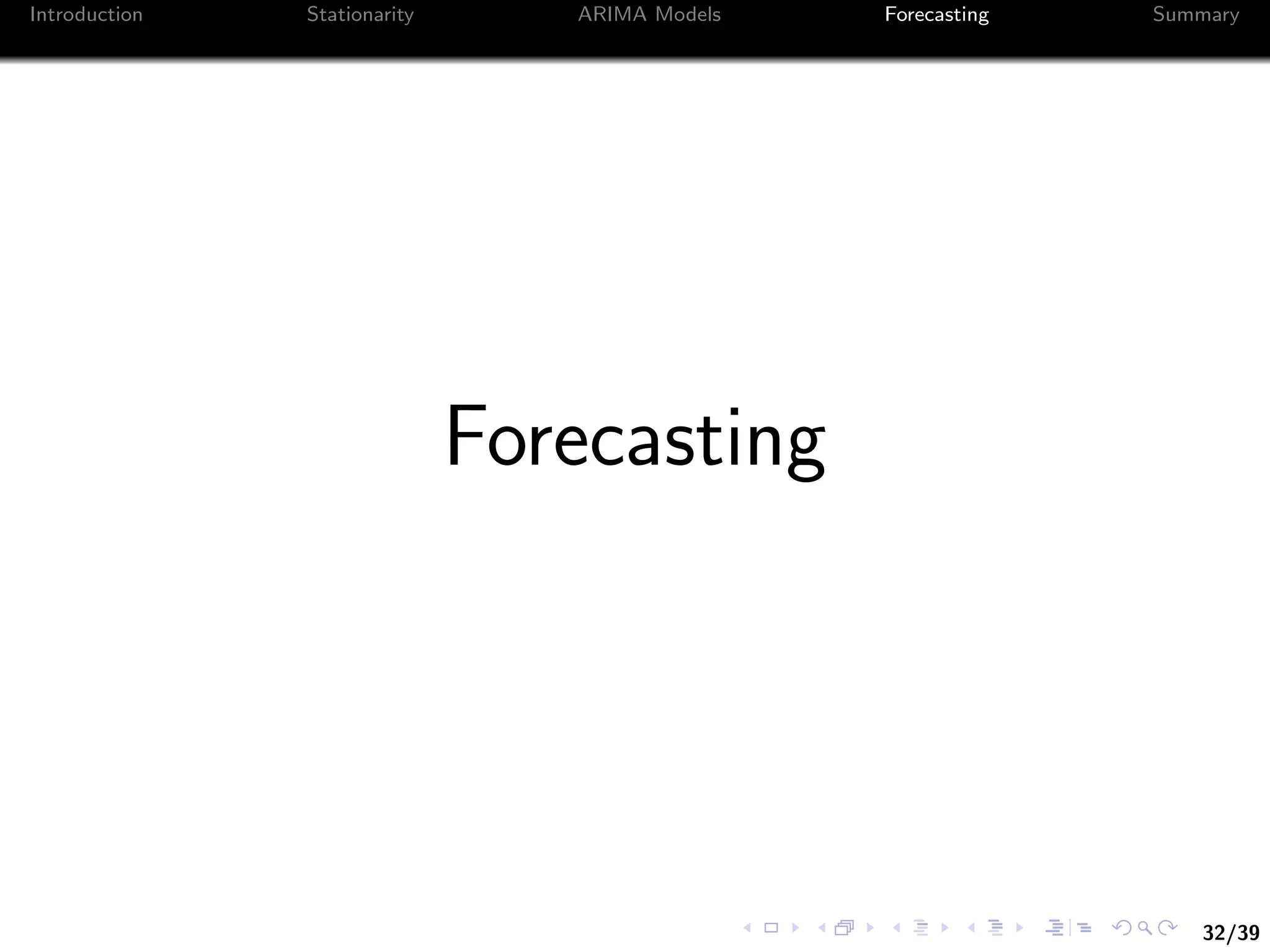

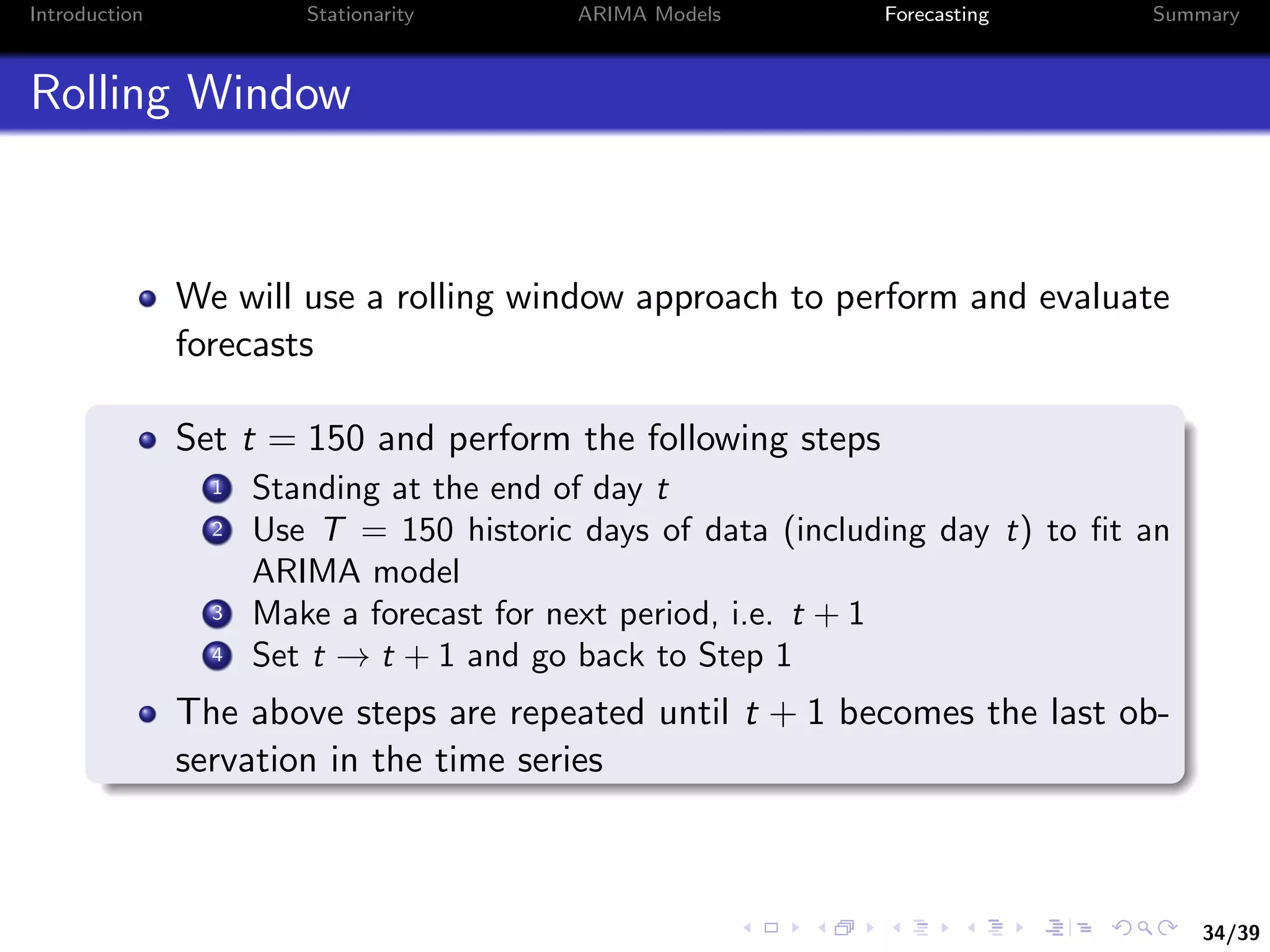
![35/39
Introduction Stationarity ARIMA Models Forecasting Summary
Example III: Forecast the SPY ETF
In total we have 252 days of closing prices for the SPY ETF
To avoid price non-stationary, we focus on returns alone
This leaves us with 101 days to test our forecasts5
We consider three models for forecast
1 Dynamically fitted ARIMA(p,0,q) model
2 Dynamically fitted AR(1) model
3 Plain moving average (momentum)
> library(forecast)
> T. <- 150
> arma.list <- numeric()
> ar1.list <- numeric()
> ma.list <- numeric()
> for(i in T.:(length(R_daily)-1) ) {
+ arma.list[i] <- list(auto.arima(R_daily[(i-T.+1):i])) # ARIMA(p,0,q)
+ ar1.list[i] <- list(arima(R_daily[(i-T.+1):i],c(1,0,0))) # AR(1)
+ ma.list[i] <- list(mean(R_daily[(i-T.+1):i])) # momentum
+ }
5
The experiment relies on the forecast package, Hyndman, 2017](https://image.slidesharecdn.com/2017-wb-2720financialtimeseriesanalysisusingr-170712071932/75/Financial-Time-Series-Analysis-Using-R-47-2048.jpg)
![36/39
Introduction Stationarity ARIMA Models Forecasting Summary
> y_hat <- sapply(arma.list[T.:length(arma.list)],
+ function(x) forecast(x,1)[[4]] )
> y_hat2 <- sapply(ar1.list[T.:length(ar1.list)],
+ function(x) forecast(x,1)[[4]] )
> y_hat3 <- sign(unlist(ma.list))
> forecast_accuracy <- cbind(mean(sign(y_hat) == sign(y)),
+ mean(sign(y_hat2) == sign(y)),
+ mean(sign(y_hat3) == sign(y)))
Finally, summarize the forecast accuracy in a table
ARIMA AR(1) Momentum
Accuracy 55.45% 53.47% 52.48%
Among the three, ARIMA performs the best
Could be attributed to more flexibility in fitting the model over time](https://image.slidesharecdn.com/2017-wb-2720financialtimeseriesanalysisusingr-170712071932/75/Financial-Time-Series-Analysis-Using-R-48-2048.jpg)
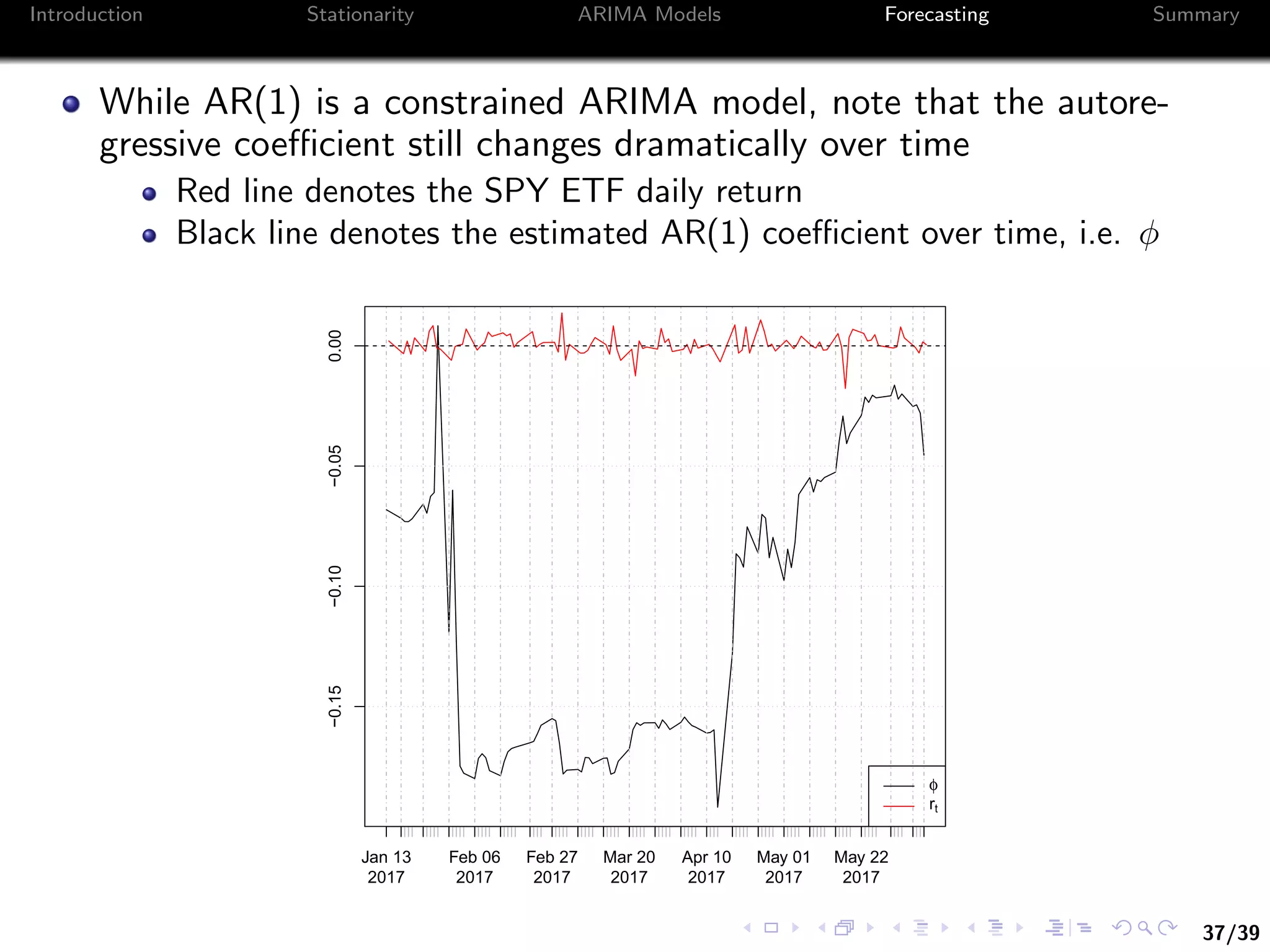
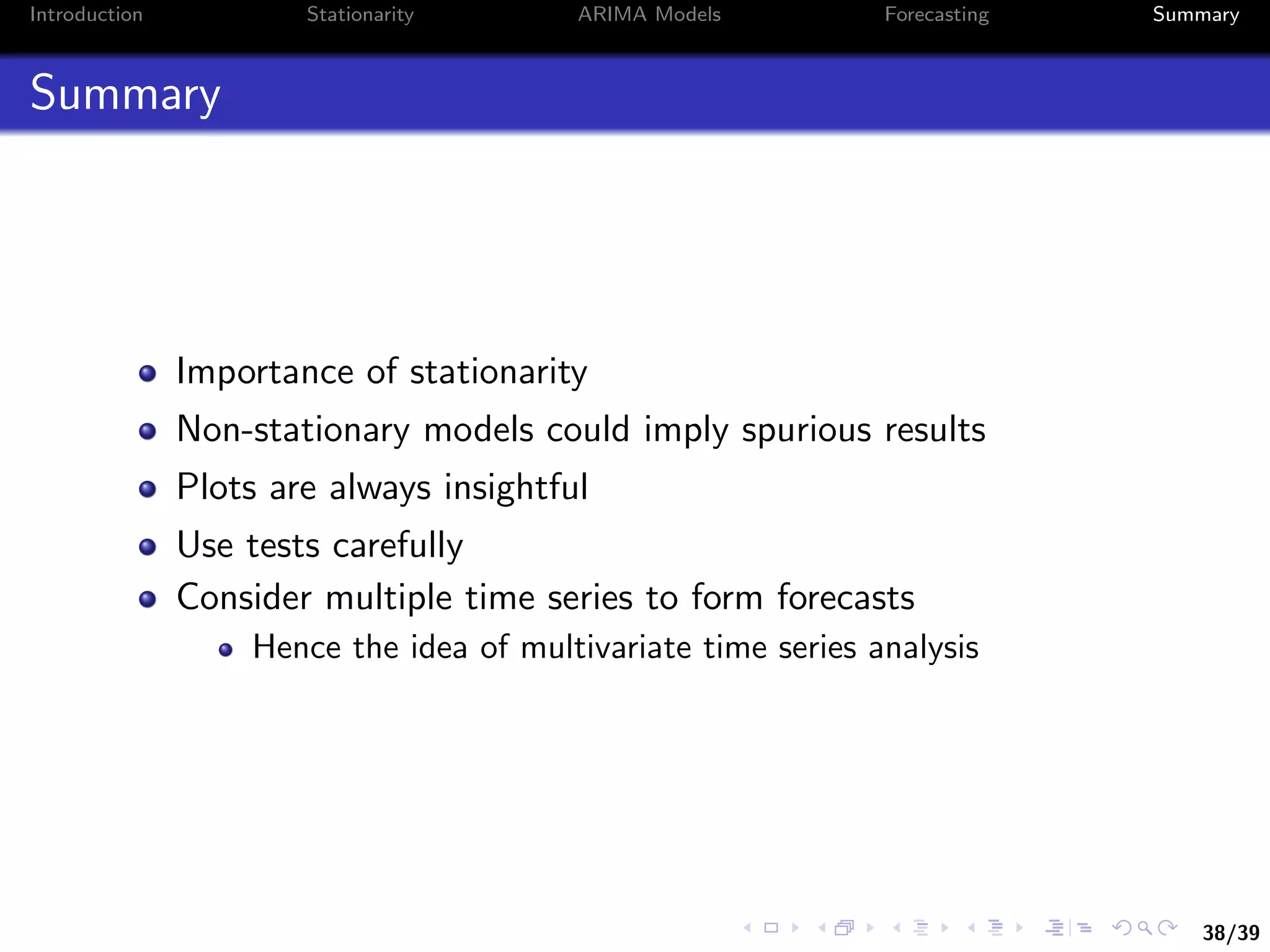

![40/39
References
References I
[]Farnsworth, G. V. 2008. Econometrics in r. Technical
report, October 2008. Available at http://cran. rproject.
org/doc/contrib/Farnsworth-EconometricsInR. pdf.
[]Grolemund, G., & Wickham, H. 2011. Dates and times made easy
with lubridate. Journal of Statistical Software, 40(3), 1–25.
Retrieved from http://www.jstatsoft.org/v40/i03/
[]Hamilton, J. D. 1994. Time series analysis (Vol. 2). Princeton
university press Princeton.
[]Hyndman, R. J. 2017. forecast: Forecasting functions for time
series and linear models [Computer software manual]. Re-
trieved from http://github.com/robjhyndman/forecast
(R package version 8.0)
[]Pfaff, B. 2008. Analysis of integrated and cointegrated time series
with r. Springer Science & Business Media.](https://image.slidesharecdn.com/2017-wb-2720financialtimeseriesanalysisusingr-170712071932/75/Financial-Time-Series-Analysis-Using-R-52-2048.jpg)
![41/39
References
References II
[]Ryan, J. 2017. Manipulating time series data in r with xts & zoo.
Data Camp.
[]Ryan, J. A. 2014. Ibrokers: R api to interactive brokers trader
workstation [Computer software manual]. Retrieved from
https://CRAN.R-project.org/package=IBrokers (R
package version 0.9-12)
[]Ryan, J. A., & Ulrich, J. M. 2014. xts: extensible time series
[Computer software manual]. Retrieved from https://CRAN
.R-project.org/package=xts (R package version 0.9-7)
[]Sakamoto, Y., Ishiguro, M., & Kitagawa, G. 1986. Akaike infor-
mation criterion statistics. Dordrecht, The Netherlands: D.
Reidel.
[]Trapletti, A., & Hornik, K. 2017. tseries: Time series analy-
sis and computational finance [Computer software manual].
Retrieved from https://CRAN.R-project.org/package=
tseries (R package version 0.10-41.)](https://image.slidesharecdn.com/2017-wb-2720financialtimeseriesanalysisusingr-170712071932/75/Financial-Time-Series-Analysis-Using-R-53-2048.jpg)
![42/39
References
References III
[]Tsay, R. S. 2005. Analysis of financial time series (Vol. 543). John
Wiley & Sons.
[]Tsay, R. S. 2013. Multivariate time series analysis: with r and
financial applications. John Wiley & Sons.
[]Tsay, R. S. 2014. An introduction to analysis of financial data
with r. John Wiley & Sons.
[]Wickham, H. 2011. The split-apply-combine strategy for data anal-
ysis. Journal of Statistical Software, 40(1), 1–29. Retrieved
from http://www.jstatsoft.org/v40/i01/](https://image.slidesharecdn.com/2017-wb-2720financialtimeseriesanalysisusingr-170712071932/75/Financial-Time-Series-Analysis-Using-R-54-2048.jpg)